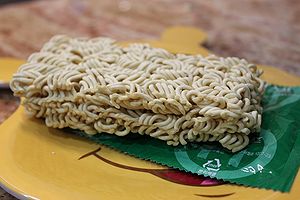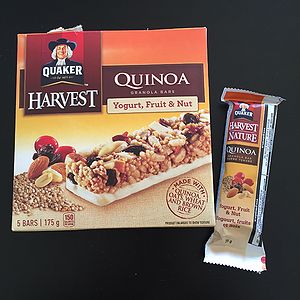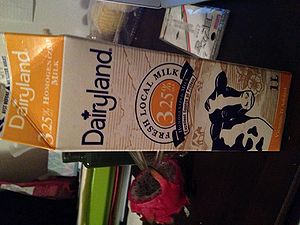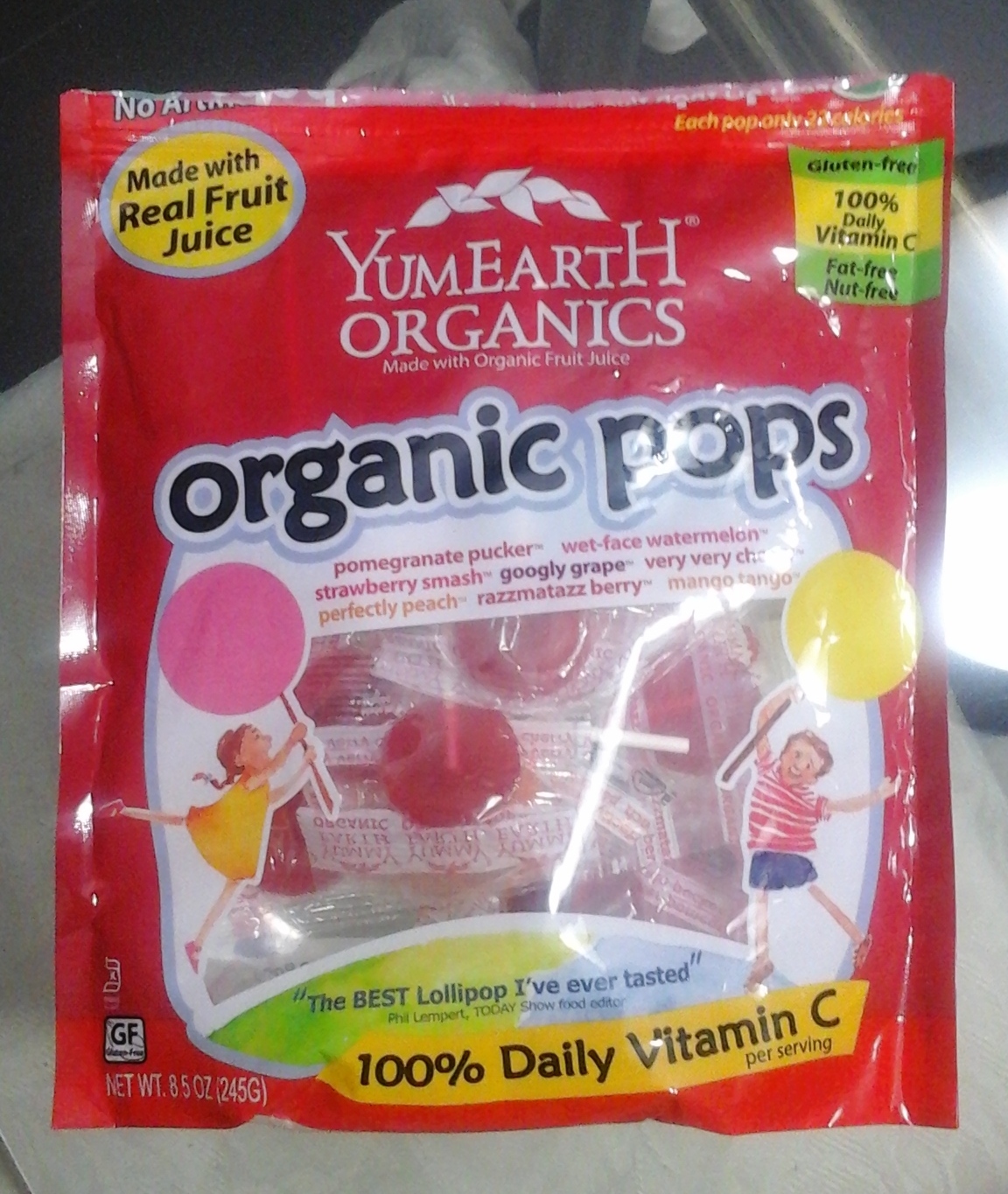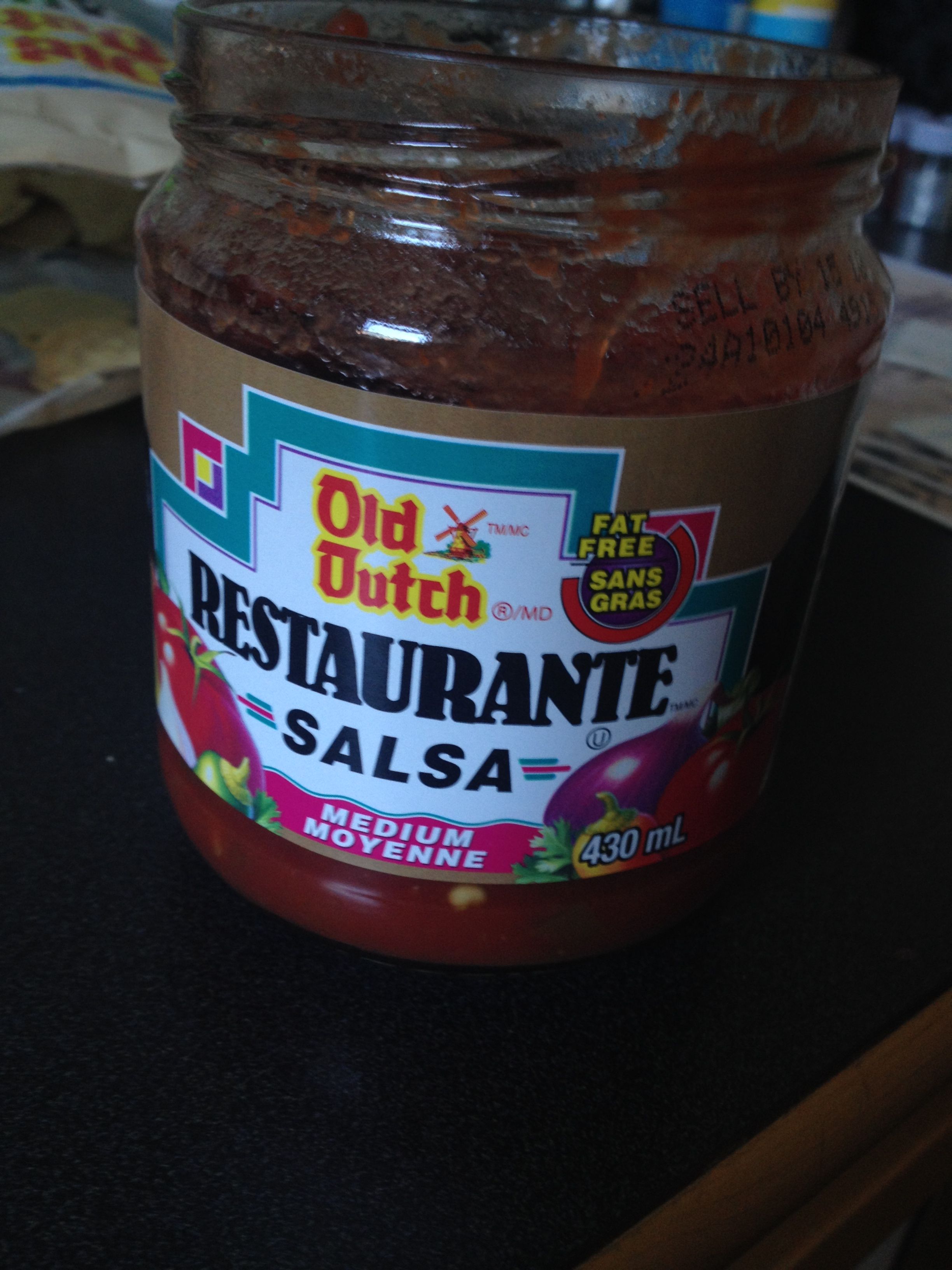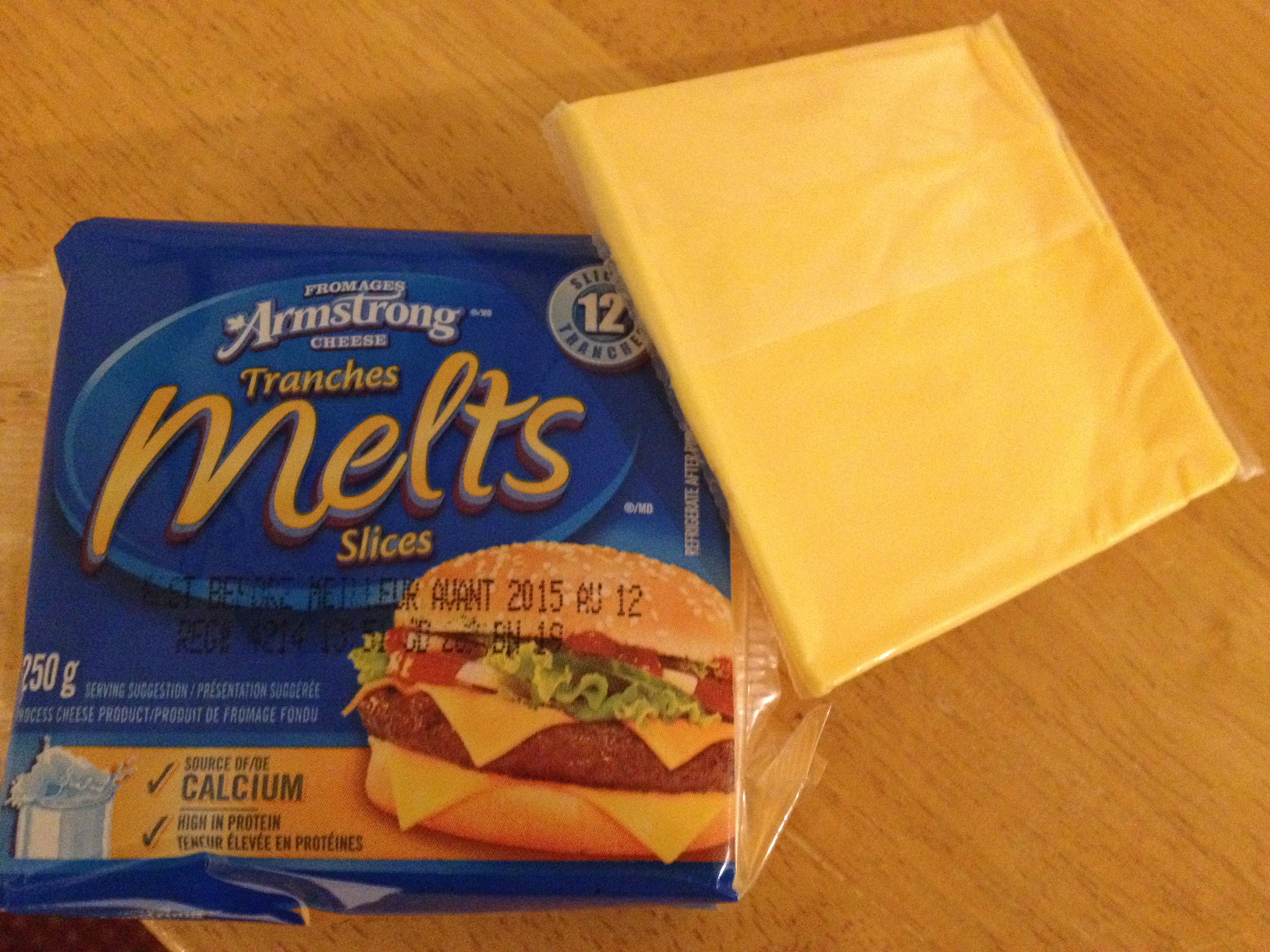Course:FNH200/2014w2/Assignment01
Assignment #1 and Assignment #3
Assignment 1, 2014W
Due Wednesday, January 21, 2015, 5:00 pm
The learning goals of Assignment #1 are to help you:
- familiarize yourself with UBC Wiki by
- logging into UBC wiki
- uploading a photo of a food
- posting required responses on a pre-set UBC wiki table
- connect personal experience with course content
Assignment #1 Activities
| Option A | Option B |
|---|---|
|
|
Assignment #3
A Reflection on Learning
Due Date: Monday, April 20, 12:00 noon
This is a time to revisit what you wanted to learn and questions you had about foods at the beginning of the course. Here is what I expect you to do as your last assignment for FNH 200.
- Revisit the questions you asked at the beginning of the course (in alphabetical order of your last name below)
- Are you able to answer them?
- If yes, please answer your own questions to your best ability. Please also provide the Lesson # that associates with your answer.
- If not, try to make connections with concepts you've learned. Educated guesses are welcome, but no wild guess please. You may want to speculate where you may be able to find the answer to your questions, such as academic/research literature, government websites, food associations sites, health organizations, etc. Answers such as 'I will google it later' is definitely not enough :) .
An example on instant noodle is provided below. I've tried to answer the questions as a 'good' 2nd year FNH 200 student :)
For Example, Under family name C
Family Names that Start with 'A'
Family Names that Start with 'B'
| Your Wiki ID | Photo of the Food | Option A: What happened? Option B: Why Did You Select This Food? |
Questions You Have |
|---|---|---|---|
| (Butcher, Maddy) |
]] FNH200PB)|thumb|(Insert Caption)]] |
(I have chosen Peanut Butter as I eat this most days and I love it! ) |
(1. How is the making process of creamy peanut butter different to crunchy peanut butter? 2. Why does it have such a long shelf life (18 months)? 3. Can anything be subsisted for the Palm Oil which is often used in peanut butter due to the huge amounts of deforestation which is caused by the harvest of palm oil? 4. How do other nut butters compare to peanut butter, nutritionally? 5. Peanuts aren't nuts, but what makes a nut a nut?) |
| (Blandford, Amelia) |
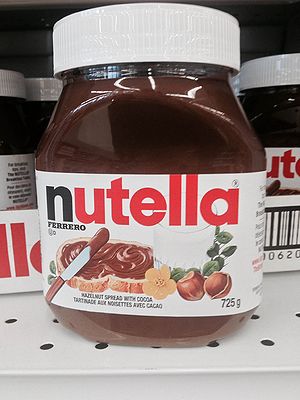 |
I chose Nutella, since it's delicious and a nice alternative to peanut butter (although it has a ton more sugar...). It's nice on toast, crepes, and fruit like bananas. |
Nutella has such a long shelf life because, although it has no preservatives, it has a lot of sugar. Adding sugar increases shelf life by absorbing any free water, which slows microbial growth.
Although it has less total fat than peanut butter, it has more saturated fat.
It has a lot more sugar compared to peanut butter (21g in Nutella vs 3g in peanut butter), but less salt (15mg vs 150mg) and less total fat (17% vs 25%). It has more saturated fat than peanut butter however (16% vs 18%). Both spreads seem to be an insignificant source of vitamins and minerals.
Nutella is made by blending hazelnuts, cocoa, skim milk powder, sugar, modified palm oil, lecithin, and vanillin.
It does not need to be stored in the fridge because the added sugar and palm oil act as preservatives. |
| (MathieuBelanger) | 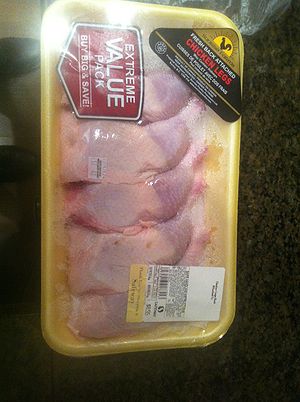 |
Food-related illness: Salmonella Poisoning
|
|
| (Berger, Julian) | File:///Users/julianberger/Desktop/The happening Bread Challah double or.jpg | 1. My good friend Manjot suffered from severe stomach pain and digestion issues for approximately five years. After numerous doctor visits and tests, it was concluded that he suffers from a severe gluten intolerance
2. a. Who was affected: My friend Manjot b. What was consumed: Gluten 3. Symptoms: Severe stomach pain, cramps, digestion issues, stomach ulcers. 4. When: Began approximately five years ago; diagnosed approximately one year ago. 5. Where: Vancouver. 6. Resolve: Numerous tests indicate a severe gluten allergy/intolerance. He is now 100% gluten free, and free of stomach issues. |
7. Further questions: Considering the recent gluten-free trend sweeping Vancouver, I am curious as to how many gluten-free individuals actually suffer from a gluten intolerance. Furthermore, I wonder what sort of negative effects gluten has on the human body, if any. |
| (Bourgeois, Michael) | thumb|(Insert Caption) | (I eat a lot of pasta, so therefore buy a lot of Pasta sauce) |
(Why such a long expiry date? (2016) Some say "refrigerate after opening", what changes when you open it vs storing it? (is it just access to air?) Is there a limitation to the ingredients in the sauce if it needs to last this long? Does the process differ between products with long shelf life and fresh made sauces, besides adding the preservative? ) |
-
Caption1
-
Caption2
Family Names that Start with 'C'
| Your Wiki ID | Photo of the Food | Option A: What happened? Option B: Why Did You Select This Food? |
Questions You Have |
|---|---|---|---|
| (Aine Coombs) | 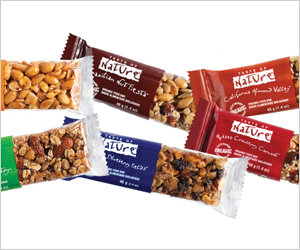 |
(I selected this food because for a few years I have cut refined sugar out of my diet as I was told this was a successful aid in weight loss. I still eat fruits and natural sugars, but just not any processed sugars. I chose this bar because it was one of the very few bars that didn't have any added sugar, however, it always made me wonder if this bar was actually any better than other bars that did have more refined sugar. It made me wonder this because all of the other bars, despite having the sugar in them that I was trying to avoid, still had less calories and less fat. This is why I want to investigate more into this bar before I commit to consuming it more regularly. Ultimately, I feel that the most important thing is everything in moderation, however I do still wish to be more informed about this particular bar and its ingredients.) |
1. Is rice syrup an ingredient to avoid if you are trying to lose weight? 2. What is rice syrup exactly? 3. What is the difference between agave nectar and honey? 4. Why do these bars have more fat and calories than other bars that have ingredients in them that are worse for you? 5. Are these bars less processed than others? (Because they only last for 12 months which is a short amount of time compared to other bars.) 6. What is the difference between sprouted flax powder and regular flax powder? Answers (Assignment 3): Question 1 Answer- rice syrup is an alternative to table sugar, and it is a more natural alternative to other sweeteners. Despite this, however, it is quite high in calories (110 calories per. 2 table spoons) and it is very high in sugar (25g of sugar per. 2 table spoons). Therefore, sugar is sugar and it is not ideal if you are trying to lose weight, especially this particular sweetener as it also has many calories. Due to this, I think that it is a good alternative if you are attempting to maintain a healthy diet, however not if you are trying to lose weight. I therefore think that I would consume this as I would prefer it to other sweeteners, however I would consume it in moderation and only occasionally. Question 2 Answer: Rice syrup is a fermented syrup in which the starch in the rice grains have been broken down and its liquid has been removed via. heat in order to achieve the syrup consistency. It is a healthy sweetener, especially compared to other unnatural sweeteners. Question 3 Answer: Both honey and agave have naturally occurring sugars, which are healthier for you than other sweeteners because they are natural. According to what I have read, neither agave or honey are more nutritious than each other. They are both equal in nutritional value, just in different aspects. For instance, if the goal is weight loss then agave is a better option than honey because it has less calories and less carbohydrates. (85 calories and 21g of carbohydrates per. two tablespoons for agave, whereas honey has 128 calories and 35g of carbohydrates per. two tablespoons.) Honey, however, is sweeter than agave, so this might make up for the fact is has more calories because you would consume and need less of it because of its sweetness. In terms of nutritional value, both honey and agave have important nutrients that the other is missing. For instance, agave has vitamin K that aids in blood clotting, and honey doesn't have this. On the other hand, honey has calcium, iron, potassium and zinc, which agave is missing. Both honey and agave have Vitamin C in common. Honey also has more antioxidant, antibacterial and antimicrobial content, and so it can act as a good preventative measure for certain illnesses. I therefore think that the differences are both large and small between these two sweeteners- it just depends on your preferences and what you wish to achieve from your diet. Question 4 Answer: I've done quite a bit of research because of questions such as this one, as I have been trying to lose weight, however have been in a conflict because I want to lose weight but healthily. For instance, there is a difference between products being healthy and products that help you lose weight. I found that a good example of this was diet vs. regular coke. Both of these are unhealthy, but diet coke might help you keep the weight off. Diet coke, however, is really bad for you because of all of the added chemicals to substitute for the sugar. In terms of these bars, they have a higher fat content and more calories, but this fat content and the calories that accompany it are good fats, for instance, nuts. Nuts are a big ingredient in these bars, and so this explains the fat and calorie content. Despite this, however, nuts and rice syrup (main ingredients in these bars) are a better healthy alternative to regular sugar and all of the other flavourings added to the more common bars. Question 5 Answer: This was hard to find the answer to, however because I found that these bars do not keep for as long as the other bars and looking at the ingredients in the other bars, they are a lot more artificial, so therefore it is safe to assume that these bars are definitely less processed and overall significantly more natural because of their ingredients. Question 6 Answer: The difference between sprouted flax powder and regular flax powder is mainly in the nutritional value. The process of sprouting increases the nutritional value of the seed. |
| (Pearl Cicci) | 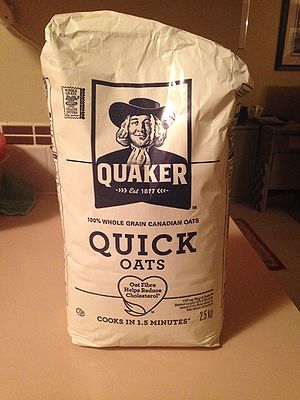 |
(I chose this photo because I love eating oats but I have never really thought of how they were made or where they come from.) |
|
| (Susanna Chan) | 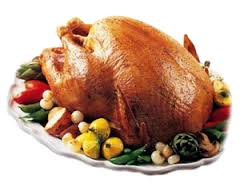 |
Option A:
1. Illness: Food poisoning 2. Who was affected? My mom and I. 3. What was consumed? Turkey and roast beef 4. What were the symptoms? Diarrhea, vomiting, and loss of appetite (gross, I know). I ended up puking (blood too) once near the end, and ended up going to the hospital to finally figure out that I had gotten food poisoning. It was not as severe as other food poisoning incidents I’ve (sadly) encountered, but I was extremely uncomfortable for almost a week. 5. When? About 1 day after Christmas 6. Where? Home 7. Resolution? Nothing really. I just let it go away on its own. I didn’t eat much meat after that incident for almost a month because I was so traumatized. |
(1. Strange enough my brother was the only one who didn’t get sick b/c he didn’t consume very much meat, but I think it was b/c he was already sick from eating too much chocolate/candy the same day.
2. What puzzled me is why I puked up blood, and didn’t really vomit. The other time I got food poisoning, it was constant puking, but this time it wasn’t. Why is that? What it actually food poisoning? The pathogenic bacteria in bad food does not alter the colour, odour, of texture, so no one knows if their going to get sick or not. Also, i learned that homes and food processing establishments are in the top 4 places where food borne diseases may occur.
|
| Isaac Choi | 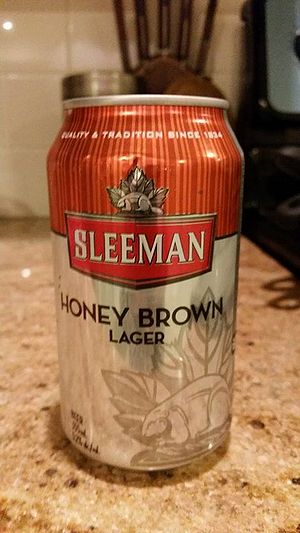 |
I love drinking all kinds (except IPA) of beer ranging from craft beer to the cheap PBR. |
Questions
Answers
|
| Chuang, Terence | 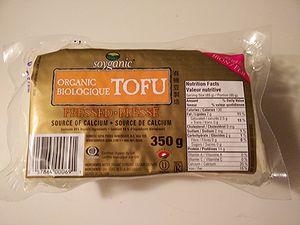 |
This food was chosen because it is a vegan source of protein and calcium. I purchased this food organically certified (QAI certification) to avoid consumption of controversial monocrop/GMO soybean. This pressed tofu is used in sautee and pan-fried meals. |
1.) Is this product, or other similar pressed/firm/soft tofu products treated with the industrial solvent 'hexane?' From studying canola oil processing for my team project, I am quite certain that typical industrial practice does indeed use hexane to extract the canola oil. It is probably unlikely that hexane is used in the processing of soy for tofu.
Again, deodourization is common in industrial canola oil production. It is probably not used in the production of tofu. Deodourization is a step taken in canola oil processing to remove the awful odour of rancid oil during manufacturing. Since tofu is typically a very low fat product, there would not be enough rancid fats (if any) to warrant a deodourizing process.
Under Canadian regulations, calcium sulphate is listed as a food additive under five categories. In tofu, it is likely used as a stabilizing (preservative) agent, and as a firming agent.
Firmness may relate to the calcium sulphate content, which is listed as a firming agent under Canadian law. Firmness is probably achieved by physically pressing the tofu into a dense solid. 5.) In the processing plant, are different methods of processing in the organic soybeans than the conventional GMO soybeans (due to factors such as shape, size and weight of the soybeans)? I am not sure, and this question may be out of the scope of this course. My guess from an applied biology background is that organic soybean and GMO soybeans are produced to similar weight/shape/size dimensions to allow easy mechanical harvesting and processing. |
| Shiela Caberoy | 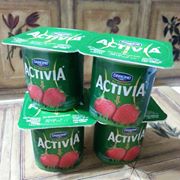 |
I chose this product because I love yogurt. It is a perfect and healthy on-the-go snack and I would love to know more about how it is processed. |
Answers:
|
| Hannah Cormack |
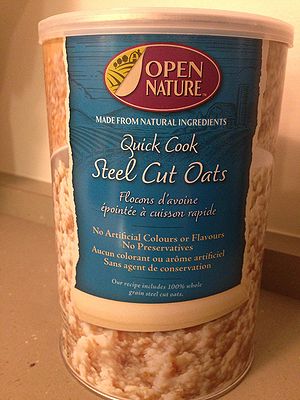 |
I chose to use this product because I prefer the texture of steel cut oats over quick oats |
I think they are just made by being placed on some kind of conveyer belt and then some kind of industrial knife probably cuts them into smaller pieces. There is probably some way to calculate that however many times the knife chops a group of these oats determines the size of the final oat product.
Quick cooking steel cut oats are cut just slightly smaller than regular steel cut oats so that they cook faster, but still different than quick oats because they are not pressed into flat flakes.
I’m not sure why quick cooking steel cut oats cook faster than non-quick cooking, but I would assume they either put and additive in them to help them cook faster (although I wouldn’t know which one would do this) or maybe they are cut smaller than non-quick cooking steel cut oats so that there is more surface area. After a quick search I found an advertisement for “Bob’s red Mill quick cooking steel cut oats,” explaining that “Our Quick Cooking Steel Cut Oats are cut a little smaller than our Regular Steel Cut Oats, making them ready in a scant 5 to 7 minutes.” http://www.bobsredmill.com/organic-quick-cooking-steel-cut-oats.html
I quickly Google searched an image of uncut oats and found images showing a large rice shaped grain.
I think it must have something to do with the starch that is from the oats, because small bits of the oats flake off and form a more powdery substance, and the starch must combine with the water to form gelatin-like water. |
| Xiaozi Chen | 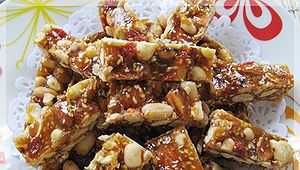 |
I chose this food because my friend is allergic to peanuts and his symptom is different from the normal symptom. He always has a nightmare after eating peanut after 4pm. Therefore, he has to eat the food containing peanut before 4pm. |
Ans: 1. We talked about the top 10 allergens in Canada in lesson 2 but we didn't talk about the syndromes caused by the allergens. I googled the syndrome online and I learned that some people may have difficulty digesting the strong taste food. Therefore, their nervous system will be get activated by the strong taste of the food and the stomach pains that they experienced due to the digestion of the food are reflected on their nightmares. I will spend more time reading this article.("Food and Nightmare", 2012, http://corcdreamingf.blogspot.ca/2012/12/food-and-nightmare.html) 2. We didn't talk about the syndromes caused by the allergens. From the online article "Food and nightmare", I learned that some strong taste food that are usually high in fat, sodium and sugar are more difficult to be digested during the day and the situation is even worse at night. So I think that my friend may have difficulty digesting the peanut at night. If I have time, I will spend more time reading this article.("Food and Nightmare", 2012, http://corcdreamingf.blogspot.ca/2012/12/food-and-nightmare.html) 3. According to lesson 4, if the shelf life of a product is more than 90 days, then it's not necessary for the the food manufacturers to put the expiry date on the package. However, I think it will eventually expire. This is because the peanut candy has peanut which is high in fats and therefore it will eventually deteriorate due to the oxidative rancidity. I may recommend to store it in a cool temperature to reduce the oxidation ( Lesson 06). 4. The brown color shown on the peanut candy is due to the browning reaction called caramelization. When the peanut candy is made, the ingredients including sugar are heated to a very high temperature around 200°C. Under the high temperature, the caramelization reaction of sugars happen and produce the caramel and butterscoth flavors. The heating of sugars also produce the the brown pigments (Lesson 02). |
| Sen Fung Chu | 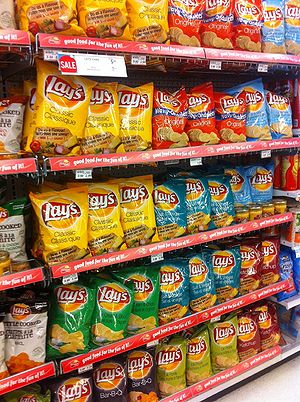 |
I chose chips because I feel like it is a food that has been processed so much that it looks entirely different from its natural form; oh, and it tastes amazing! |
Ans: 1. There are many steps, or levels of processing, required for a bag of potato chips to meet regulations set by Health Canada (lesson 1 and 4). The potatoes are processed, and disinfected via one of many possible ways (lessons 5-8), sealed and labelled accordingly (lesson 1). There are steps specific to potato chips that were not covered in the course, but the general steps of potato chips making were generally covered in this introductory course. 2. The chips are able to retain some nutritional value through all those steps of processing, but they lose much nutrients from their original form as a potato (lesson 11). To compensate for the loss in flavour, nutrition, or even texture, substitutes can be added (lesson 3 and 4). 3. The option to add flavouring and additives, such as MSG, to potato chips allows for the customization of the product to our own liking. In other words, I think that chips taste better because of the flavour we choose to buy. Potatoes naturally only come in original (minus the salt, fats, and grease) flavour, but adding dill, vinegar, barbecue sauce, or ketchup (or whatever you prefer) to it makes it more appealing. 4. A quick search on Wiki shows that Potato chips may have originated from New York, by a frustrated cook working with a picky fried-potato customer. 5. Chips are deep fried potatoes and contains a lot of salt (among other additives, natural or chemical). These ingredients all may contribute to excessive intake of lipids and salts into the body causing high blood pressure, high cholesterol, and weight gain. Since chips are a high in fats and lipids, they also make the consumer feel fuller, in turn making them not want to eat more nutritive foods such as fruits and vegetables. This may leading to loss of nutrition, such as the vitamins and minerals lacking in chips, when consumed consistently, in the long term. |
| MeganClarke | 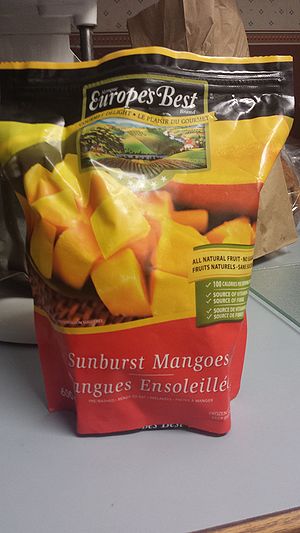 |
I found out I had a food allergy because I had an allergic reaction.
|
6. I wonder why I had suddenly developed this allergy, as the only allergies I have ever had disappeared after age
7. I also wonder why I could eat cooked mangoes, but not fresh or frozen ones?
|
| Benjamin Chiu | 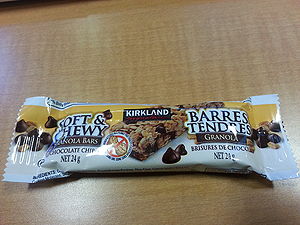 |
With my current lack of knowledge in this field, I somewhat believe that simple processed foods can be more conveniently transported, efficiently stored, easily made, and used to provide nutrient-dense substitutions for areas that lack the ability to sustain themselves. Allocating the minimal (but necessary) equipment to areas such as these creates jobs and provides accessible options of distribution to other critical areas. |
Questions:
Answers:
|
| Crystal Chu | 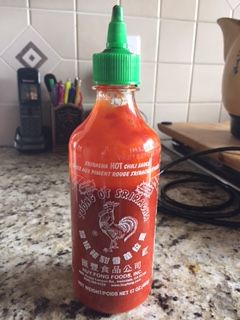 |
I chose Sriracha Sauce because I love spicy food, and this is just the right amount of spiciness to add to all my foods. I like to add this to a wide range of foods that I eat such as sushi, pho, fried rice, noodles, etc. |
Ans: 1. A quick search on Wiki showed that Sriracha sauce is made from fresh red jalapeño chili peppers which contain no added water or artificial colours. Therefore, the colour of the sauce simply comes from the red jalapeño chili peppers. 2. There is no expiry date on the bottle because a durable life date is only required for foods with a storage life of 90 days or less (Lesson 4). In terms of expiration date, I believe it does not expire according to my knowledge. 3. According to Wiki, Sriracha sauce is made from a paste of chili peppers, distilled vinegar, garlic, sugar, and salt; Frank's hot sauce is made from a variety of cayenne peppers, vinegar, and garlic; and Tobasco is made from tobasco peppers, vinegar, and salt. I think that Sriracha sauce is more viscous than the other two hot sauces because it is made from a paste of chili peppers. 4. According to Wiki, to keep the sauce hot, the company produces only up to a monthly pre-sold quota in order to use only peppers from known sources. 5. I read an article online where an individual drank 3lbs of Sriracha sauce and ended up having an unpleasant time in the washroom, but there does not seem to be any scientific findings that show the negatives of consuming too much Sriracha sauce. However, it is important to keep in mind that eating anything in excess is bad for you. |
| Chen, Joey |  |
I chose this food because it is a dairy product. I used to be lactose intolerant when I was a child and any milk products would have caused me to get hives all over my body. |
Answers:
|
Family Names that Start with 'D'
| Your Wiki ID | Photo of the Food | Option A: What happened? Option B: Why Did You Select This Food? |
Questions You Have |
|---|---|---|---|
| (Madison DiDomenicantonio) | I have been eating Quest bars for the past couple years and I love them because they have very few carbs and a small amount of sugar while having 20 plus grams of protein! There is a wide variety of Quest protein bar flavors, such as; brownie, cookies and cream, cookie dough, cinnamon bun, apple pie, peanut butter and jelly, and smore. They definitely have a very unique texture but are very delicious and from what I can tell, nutritious as well. I would like to know more about how they make them such a great snack choice! |
1)How are they manufactured with no carbs? 2)What source of protein are they using? 3)What are the chocolate chunks made out of? 4)How are there no artificial ingredients?) | |
| (PhaedraDill) | [[ |
(I love waffles because its like cake for breakfast...and I love cake. Waffles can also be made savory or sweet and the versatility makes it a meal I can have anytime during the day. Its good for a weekend treat and making waffles for the family with my little sister is on of the best ways to spend a weekend morning ) |
(1)Is there healthier ways to make waffles? Answer: Yes, you can use whole wheat flour instead of white flour and top them with berries instead of syrup or whipped cream 2) Could I replace flour with quinoa or another grain? Answer: Yes you can use quinoa flour 3) Is it really unhealthy to have waffles everyday of the week? Answer: Its important to eat everything in moderation. Waffles are considered a carbohydrate based food which is thought to be the cause of gaining weight over time. Also if we use sugary toppings that can also be bad for us if we eat them too much. 4)How are frozen waffles preserved Answer: according to the course I believe waffles are preserved by being frozen. Certain pathogenic bacteria can not reproduce at temperatures below -4 and freezing the product will further slow the process of spoilage. Maintaining freezer temperature is important to keeping the taste and texture of the waffle the same. 5) How are frozen waffles manufactured? Answer: according to the course material I believe frozen waffles are frozen by the plate freezing system. This would drop the temperature of the waffle quickly and evenly and because its a fairly flat product this method seems viable. ) |
| Maria Michaela Darjuan | 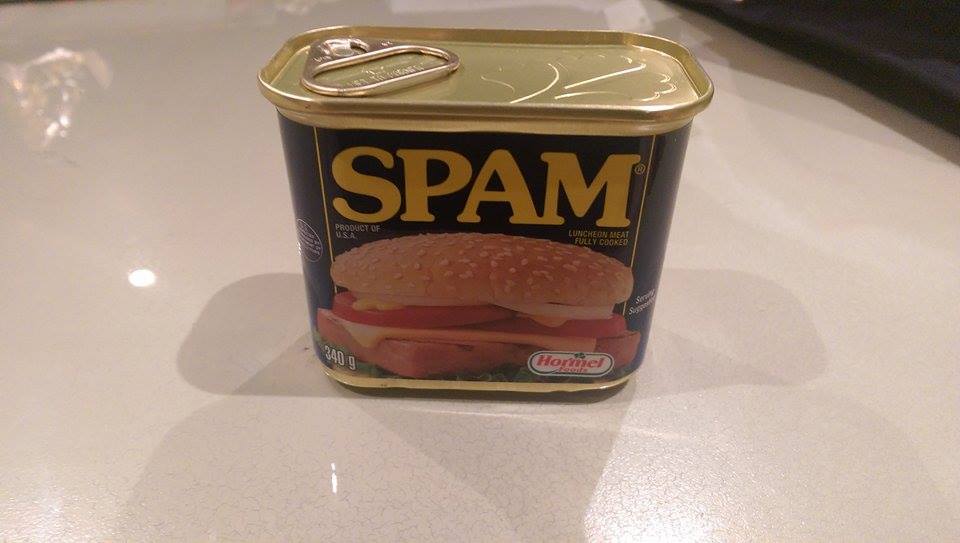
|
I selected this product because my family has a large stash of this in our pantry. My friends also eat it. Although it is very convenient, since it is practically ready to eat, I always wondered what it is really made of. |
1. What kinds of meat is it composed of? 2.What kind of process allows it to be ready to be eaten? 3. Are there any nutritional value with eating this? 4. What allows it to have a soft, semi-solid texture 5. Do these last forever? Answers: 1. We didn't really look into the composition of spam and if the meat products from Spam make the product a food item Classified as "meat" in Canada. In lesson 4 and the website (http://laws.justice.gc.ca/eng/regulations/C.R.C.,_c._870/), we leaned about the standards of food identity and composition and were able to compare different regulations regarding what makes a food product what it is. From looking at the Canadian Food and Drug Regulations, Spam would be closest classified as a preserved meat because it is "cooked or uncooked meat or meat by-product that is salted…" an ingredient of spam is also sugar. 2. From lesson 6, we learned the processes of thermal preservation. The Spam product is placed in cans where it is heated. The heat will not only kill any bacteria that may be present but also cook the meat which makes it nearly ready to eat. 3. We didn't really touch upon nutritional values of foods and their effects on the human body but in lesson 11, we learned that thermal processing can cause some loss of nutrients. We also learned that HTST processes accelerate spore destruction and has the ability to retain a product's nutrient content. On the other hand, since Spam is heated in the can for about three hours, the product probably would have lost most of its nutrients. 4. The ingredients of Spam is pork with ham, salt, water, modified potato starch, sugar, and sodium nitrite. As we learned from lesson 2, most food products have water, even in meat. This probably gives it a softer consistency. Salt and sugar reduce the amount of free water in a product, which makes the product more solid and makes an undesirable environment for growth of harmful microorganisms. 5. The Spam product is canned and undergoes ultra high temperature. In lesson 6, we learned that from ultra high temperature used by the canning process microorganisms will be killed and a vacuum can be made. This can create a hermetic seal, which prevents the transmission of gasses, water, and microorganisms. Because of this and if packaged correctly, Spam has the ability to last forever. |
| de Ocampo Inna |
I selected these lollipops because this is my go-to candy for when I'm feeling healthier (hehe). I actually really love savoury foods, but when I'm craving something sweet and tart this is what I snack on! |
1. One of the ingredients is ascorbic acid. It happens to say there is 100% Vitamin C. What does this mean? When a product states that there is 100% Vitamin C, it means that one serving provides 100% of the Vitamin C that someone should consume in a day. [1] 2. It says on the back that it's non-gmo. What does that mean? GMO stands for Genetically Modified Organisms. GMOs consist of plants, animals and microorganisms where intentional manipulation results in a change to the heritable trait(s) of the organism. This can include modern gene technologies such as recombinant nucleic acid technology where a foreign piece of DNA (deoxyribonucleic acid) is inserted into the genetic material of the host organisms. [2] 3. How much better would organic lollipops be than regular lollipops in the long run? Organic products have lower levels of pesticides compared to conventional products because of the prohibition of use of pesticides. Instead, natural pest control methods are used. Nutritionally, I don't think there would be much of a difference between organic and regular lollipops. Also, it is important to note that organic can be a bit more expensive than regular lollipops, but it shouldn't be a problem since candy isn't normally eaten on a regular basis. [3] 4. It was produced May 9, 2014 and expires 2 years after. Would it still be safe to consume in 4 years, for example? (not that I would wait that long) Hard candies, such as lollipops, have a longer shelf life than candies with different properties. I think that as long as they are kept in proper conditions (cool, dry, dark storage and kept away from heat and moisture) then the shelf life can be extended. However, a way to tell if hard candies have undergone degradation overtime is if the outer part of the candy is no longer hard, and has a gooey consistency in which you can bite into and make a dent with. The expiry date may also have to do with the supplier's recommendation, and not necessarily the consumer's safety. 5. Each lollipop has "only 22 calories". Why are calories so important? Calories are units of energy and are used to describe the energy content of carbs, proteins, and fats within a food. They provide the energy our bodies need in order to stay healthy, but there is a limit of the calorie intake for each person. | |
| Dirk, Aspen |
Chips and Salsa is one of my favourite snacks to have, either it be when I'm studying, watching Netflix, or spending a Friday night with friends. There is a variety of chips to choose from, as well as different heats for the tomato dip. It is the universal munching food, and is easily one of the cheapest and easiest snack to enjoy. |
1) How can the tomatoes stay fresh for so long? - In this case, the tomatoes were preserved with sugar and container itself is classified under modified food packaging. Once opened, the seal pops due to the influx of oxygen! If left unopened, the salsa can remain in a cool, dry storage for up to 6 months. However, once opened, the oxygen begins to react with the salsa and microorganisms begin to grow. This is why salsa should be eaten within 2 weeks of opening the container. 2) Why do the chips get stale if the bag is left open? - This is caused by the oxygen in the air mixing with the contents of the bag. Instead of Nitrogen being the primary gas in contact with the chips, it is now oxygen which initiates the process of oxygenation. The O2 begins to chemically react with the chips, making them stale and hard. 3) Why does salsa come in either a glass jar or a plastic container? - Glass jars are more resistant to corrosion, allows the consumer to see the product they are buying, and do not alter the taste of the food. However, they are heavy and bulky, which means they must be handled with extra care when beings processed. - Plastic containers are airtight sealed and thermally processed in steam in order to achieve complete decontamination. It is cheaper to buy products that are in plastic containers, but some people report a slight change in taste for what they are paying for. 4) Why does cilantro in the salsa taste like soap to some people? - To some, cilantro is delicious. To others, it reminds them of bath time. Those who are not of Mediterranean or South American descent are those who have a predisposed distain to the green herb. It is a primal instinct that can be overrun of the brain makes connections with other flavours and aromas that are pleasant to the individual. 5) Is it the seeds in the peppers that give salsa the heat? Why? - It is the capsaicin chemical found in peppers, specifically concentrated in the seeds, that give of the fiery heat everyone seems to enjoy. If the salsa is too hot for an indiviudals taste, then all they need to do is cut open the pepper and wash it under cold water. This process will help remove some of the seeds without losing the pepper flavour that is necessary for the perfect salsa. | |
| Poonam Dattani |
I love cheese. I loving having it with my bread, pasta, vegetables or even on it's own. It's also one of my daily dairy servings. I wish it wasn't as fattening as people claim it to be. But I believe it's because of it's fat content that I like it so much. |
1) Why is cheese yellow in colour? 2) What gives cheese slices the shiny/slimy texture? 3) How are different types of cheese made? 4) Why is cheese usually salty? 5) Why is mouldy cheese edible?
2) The shininess/sliminess is caused by wax which is applied on cheese for preservation purposes. The wax prevents growth of mould and retains moisture as the cheese ages. 3) Production of many different types of cheese begin similarly, however variations in the later part of the production results in the different varieties. For example, Swiss cheese is initially made in the same way as Cheddar cheese but later requires the addition of a second bacterial culture, Propionibacterium shermanii. 4) Salt is added to cheese for many purposes including, to draw out whey, flavouring, to prevent the growth of proteolytic and lypolytic spoilage causing microorganisms, and to create favourable conditions to support the function of rennet and lactic acid producing starter culture. 5) Cheese that is processed with mould is edible because manufacturers use particular types of moulds that are safe to eat and are inoculated in the cheese under the right processing conditions that are required for the production of quality cheese. However, if mould grows on the cheese during storage (in the home refrigerator) then care must be taken before consuming it. For hard cheeses, mouldy parts can be cut off and the rest of the cheese can be consumed, but the same cannot be done for soft cheeses because mould toxins can easily spread through them and therefore should be thrown out. |
Family Names that Start with 'E'
| Your Wiki ID | Photo of the Food | Option A: What happened? Option B: Why Did You Select This Food? |
Questions You Have |
|---|---|---|---|
| (Insert Your WikiID) | thumb|(Insert Caption) | (Insert Answers) |
(Insert Responses) |
| (Insert Your WikiID) | thumb|(Insert Caption) | (Insert Answers) |
(Insert Responses) |
| (Insert Your WikiID) | thumb|(Insert Caption) | (Insert Answers) |
(Insert Responses) |
Family Names that Start with 'F'
| Your Wiki ID | Photo of the Food | Option A: What happened? Option B: Why Did You Select This Food? |
Questions You Have |
|---|---|---|---|
| (Qianfan) | 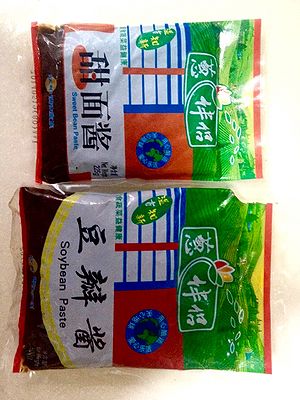 |
(As a fan of Shandong cuisine, most of my favourite dishes are cooked with soy paste. One interesting fact about this ingredient is that, unlike many types of western condiment, soy paste itself tastes plain. However, Shandong cuisine would have been dreadfully dull without a simple mix of soy paste.) |
(1. How is soy paste made? 2. What is the difference between different kinds of soy paste? 3. Why cuisine tastes better when cooked with soy paste? 4. Why soy paste is commonly used in Northern Chinese cuisine? 5. Are there any downsides about soy paste, especially when people are eating too much of it?) |
| (sfloarea) |  |
(I chose this beverage because I am interested in the chemical processes that occur in the production of alcohols. The reason why I chose sparkling wine instead of other drinks was because, while I know the procedure of turning grapes into wine, I do not know how it becomes carbonated.) |
(1. Why do certain drinks have different names, like champagne and sparkling wine? 2. Why are most of the sparkling wines white or rose, but not red? 3. How is the process of making a sparkling wine different from a regular wine? 4. Are there other significant differences between sparkling and regular wines, such as their mineral contents? 5. What are the best grapes for making sparkling wine? Answers: 1) There is very little difference between the two drinks in terms of classification. For a sparkling wine to earn the name ‘champagne’ it must be made via the traditional processing method and with grapes from the Champagne region in France. (1) 2) The color of the champagne is affected by the processing method. In the case of white sparkling wine, it can be made from any type of grape, including red ones, as long as there is not contact with the skin while fermenting since this will results in a rose. (1) This is due to the gentle method of extracting the juice, but the rose color can also be added by blending in a little red wine. (1) 3) There is a secondary fermentation phase activated by adding yeast (Lesson 9). In the traditional method, the yeast is added to the bottle before it is sealed. (1) 4) It seems that other than the secondary fermentation, there is no difference between regular wines and champagnes in regards to their chemical makeup. However, due to the additional step, champagne may not be as sweet since more of the sugars in the drink would have been consumed by the yeast to produce the CO2 (Lesson 9). 5) For champagne, the only types of grapes that can be used are Chardonnay, Pinot Noir and Pinot Meunier. (1) Sparkling wines seem to be able to be made from any type of grape. For more information, I will look at “The Oxford Companion to Wine” (3 ed.) by J. Robinson. 2006. P150-153. References: 1 Champagne. (n.d.). In Wikipedia. Retrieved from Wikipedia database. http://en.wikipedia.org/wiki/Champagne) |
| (NingrongFu) | 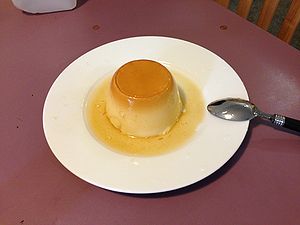 |
(Japanese styled custard is one of my favorite desserts. It is soft and sweet, and always makes me feel delighted. While custard can be found in nearly every grocery store, it is also easy to make it at home. ) |
(1. How can a processed custard be stored for about 6 months? 2. What makes custard full of moisture? Where does the liquid covering the custard come from? 3. What are the factors, except heat, that denature the protein contained in eggs? 4. What method has been used to kill the bacteria during processing? 5. To what extent will the nutrients in a custard be destroyed during processing? For question #1, the processed custard can be stored for long is probably because some chemicals that have antimicrobial properties are added, as described in Lesson #5. It is also because the vacuum packaging and low temperature preservation, as described in Lesson #6. 2. I guess the moisture is from the water added during processing and the liquid sweeteners. The environment in refrigerators (the storage place for custard) has a high level of humidity, which is probably also one of the reasons why the custard is full of moisture. I will refer to a website of custard manufactures to figure out the answer when I have time. 3. We never talked about protein denaturation in the course. But based on my learning from other courses, pH is also a factor that cause the denaturation of proteins. Excess amount of salt is also a factor affecting this denaturation, and this process is reversible. When I have time, I will go back to this wiki page talking about protein denaturation to find out more answers http://en.wikipedia.org/wiki/Denaturation_%28biochemistry%29 4. Based on Lesson #6, the main methods used during custard processing are probably pasteurization and the adding of antimicrobial chemicals. Because one of the ingredients in custard is milk, pasteurization is necessary to kill most of the spoilage causing microorganisms in milk. As described in answer #1, chemicals may be used to expand the shelf life of custard, i.e. it is another method to kill the bacteria contained in custard. 5. I guess a significant amount of nutrients such as proteins and vitamins contained in custard are destroyed during processing and storage because heat and chemicals can cause the loss of nutrient content. I will read through this website when I have time http://www.legendairy.com.au/dairy-foods/dairy-products/custard ) |
Family Names that Start with 'G'
| Your Wiki ID | Photo of the Food | Option A: What happened? Option B: Why Did You Select This Food? |
Questions You Have |
|---|---|---|---|
| (TonyGuang) | 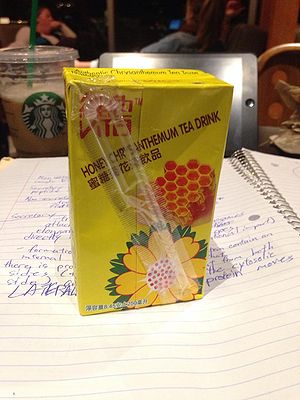 |
| (I have been drinking numerous drinks from the Vita company since I was little. My mother would tell me it was good for me because it got rid of (in what Chinese people call) "pathological heat". So this drink was my first introduction to Chinese medicine and beliefs.) |
(1. Are there any medicinal properties to this drink? 2. How are the artificial ingredients synthesized? 3. What percentage of this drink is water? 4. What natural ingredients do they use if any? 5. Can it cause diabetes?) |
| (Zishan Guo) | 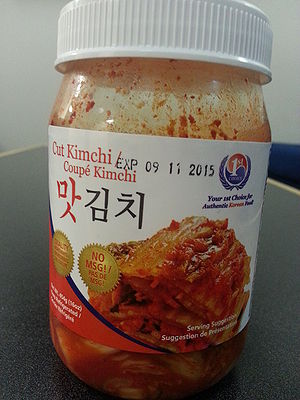 |
(I selected Kimchi because I enjoy having this Korean side dish. However Kimchi is far more than a side dish, It can make a number of different dishes like soup, fried rice and pancake.) |
(1. Kimchi is a fermented food. Would it have a negative effect to the gastrointestinal tract when people have a lot of Kimchi? Nitrosamines are produced during fermentation. Some of nitrosamines are potent carcinogens. There is a possibility that over-consuming products which contain nitrosamines can lead to cancer. While Kimchi consists of various microorganisms that aid in digestion. Humans are exposed to nitrite for many years. Having food that have nitrosamines is not a significant risk to our health only in acceptable daily intake. -Chapter 4 2. How much vitamins remain after processing? During processing, some loss of nutrients is unavoidable. In many cases, fermented food are more nutritious than unfermented food. Benefits of Fermentation Fermented foods in many cases can be more nutritious than the unfermented original materials. According to chapter 9, there are benefits of fermentation. Fermentation can improve the nutrition value and synthesize some nutrients. It is difficult to determine how many nutrients in the product before and after processing. -Chapter 9,11 3. What substances in Kimchi provide the sour taste? Lactic acid bacteria convert cabbages to Kimchi and provide the sour taste. -Chapter 9 4. Can over-consumption of Kimchi or other fermented food leads to cancer? Fermented food contain nitrosamines and some nitrosamines are carcinogens. It might lead to cancer if people over-consume these products. When people have fermented food in acceptable amount, there is not a significant risk. However, the effects of people of over-consuming fermented food are not the same because they have different health status. -Chapter 4,12 5. Is there another method to make a healthier Kimchi? Try to make your own Kimchi. Kimchi that is produces in factories contains a lot of food additives and preservatives. The substances are added to ensure the quality and flavor. Less additives and preservatives are better to our health. When you make your Kimchi, you can decide not to add them.) |
| (Insert Your WikiID) | thumb|(Insert Caption) | (Insert Answers) |
(Insert Responses) |
| JulieGordon | 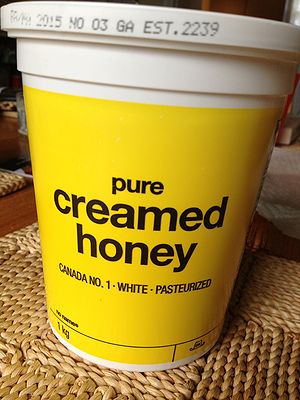 |
I chose honey because as I was preparing to submit this assignment, I was drinking tea with honey added to it to soothe my sore throat. I had to choose between the liquid and creamed honey in our cupboard, which made me curious about the difference between the two. |
1. How do liquid and creamed honey differ in their preparation methods? 2. According to the expiry date (May 2015), it only lasts a few months. What causes it to go bad? 3. Why does honey soothe my throat and make it tingle slightly? 4. How does creamed honey go from a solid to completely dissolved in my tea? 5. Are there any nutritional differences between the liquid and creamed states of honey? |
Family Names that Start with 'H'
| Your Wiki ID | Photo of the Food | Option A: What happened? Option B: Why Did You Select This Food? |
Questions You Have |
|---|---|---|---|
| (HuangMelina) | 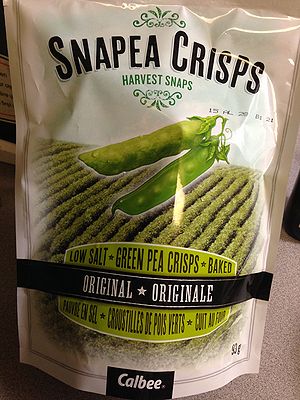 |
I have always found "healthy" snack alternatives interesting. I always wonder how healthy they actually are. My friend introduced this type of snack to me last semester and I quite enjoy them. They're not as satisfying to my taste buds as chips are, but internally I feel better about eating these than I do about chips because they're made from something green. |
There's a great deal of oil in this product, so maybe it's not as healthy as I deemed it to be. We did not really delve into the nutritional aspect of food in this class.
We also did not talk about food production in class, however, we did learn how food is preserved. The packaging was probably sterilized by hydrogen peroxide and the food by high temperature processing and both components were brought together under sterile conditions to keep them sterile. Thus, the food is shelf stable and would not contribute to disease when ingested.
This is also a question that I cannot answer with the arsenal of knowledge gained in this class. But if I were to speculate, they probably use defective peas. Like the apple example from earlier in the class, the apples that were not cosmetically perfect enough to be sold in stores are hauled to other places to be processed into other apple products such as apple juice, apple sauce, iPads (I joke), etc.
This can be answered if I examine the company. I'm guessing California? California has a long growing season, and despite their water shortages, they're managing pretty well.
This question kind of relates back to our last lesson in the class dealing with trends in the food industry. Although this food does not contain any added nutrition, it can be considered to be high in fibre, making it an almost-functional food. With the population aging, foods that promote health or seem healthier than traditional foods are trending. |
| XiaoHan | 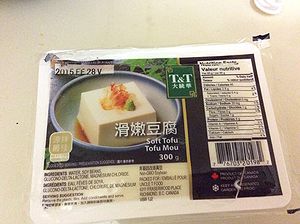 |
I like eating tofu, and I want to made by myself. However, I don’t know how it is made, and what other ingredients I need besides soy beans. |
A: We didn't refer to related knowledge on the class. But I searched information through the Internet, and I think it is because soybeans mainly contain proteins and beans like soybeans can be made into tofu. However, some other beans including red beans and mung beans mainly consist of starch, which cannot be made into tofu.
A: We didn't refer to related knowledge on the class. The difference is how many water is in the tofu. As more and more water go out of the tofu, the protein and fat will go up as well.
A:We didn't refer to related knowledge on the class. And I think the most abundant material should be protein.
A: Although we refer to fermented food on the class, I have no idea on this question.
A: Tofu contains too much protein and cannot be absorbed by human body. Then it can give rise to dyspepsia. |
| MollyHartley | 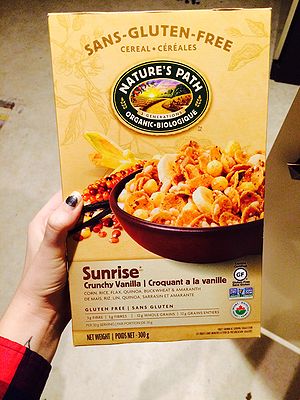 |
I chose this cereal because I am gluten-free and it can be really difficult to find a cereal that isn’t really bland. This one is a really tasty vanilla flavour that I love. |
A: I am guessing this is because gluten is a protein, so the gluten-free products lack that protein. They replace gluten with a polysaccharide to make gluten-free products which is a carbohydrate not a protein (Lesson 2).
A: We never discussed adding flavours to food in FNH 200. Perhaps it is similar to adding sugar substitutes to food, or maybe is coats the cereal so the cereal is doused in it before being packaged. There is a Wikipedia page on Flavours and it references some articles I could read.
A: There is a gluten-free certification requirement for gluten-free products to contain less than 20 parts per million (ppm) (NFCA/GFCP), less than 10 ppm (GFCO, QAI/NSF International) or less than 5 ppm of gluten (CSA Seal of Recognition). http://www.celiaccentral.org/gluten-free-certification/
A: The flakes are made from starches such as corn meal, brown rice flour, yellow corn flour. I found these ingredients on the box, but we also learned about starches in Lesson 2 of FNH 200.
A: This cereal is under the philosophy of working within the laws and systems existing in nature to achieve a healthy environment that is sustainable long-term. Rather than relying on pesticides, chemicals, or genetically modified seeds to grow their food, they use what nature intended - good ol’ fashion compost, cover crops, and soil rich in microbial life. These laws are upheld by the Canadian Food Inspection Agency. http://ca-en.naturespath.com/about/certified-organic |
| Huang, William | 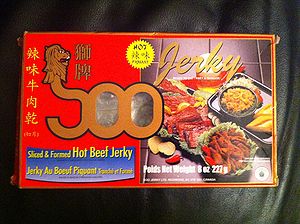 |
For as long as I can remember, I've been a huge fan of meat - I absolutely love eating meat. However, looking back to when I was a kid, it is apparent that there was one meat product snack in particular I enjoyed the most - Jerky. |
Answers: 1) This type of jerky is flat because they mix and marinate ground beef and then roll it out into a thin layer. 2) They flatten this jerky before they cook it. 3) The meat is marinated and formed into strips (and marinated again on the surfaces) and is then cooked in an oven. After some other processes, the meat will then be placed into an area for drying (tray drying; Lesson 8). 4) The Soo corporation did not have these specific information, but they follow regulations set by CFIA, so their products must have a water activity (Lesson 2) of less than 0.85 to prevent microbial growth, Additionally, I would assume its water content to be less than 65% since it is dried meat and fresh meat has 65% water content. 5) There was also no information available on this since it's part of their secret recipe. However, I believe they had a few trial and errors runs to find how long and at what temperature to dry their meat for the perfect texture and to achieve a water activity of less than 0.85 to comply with regulations. |
Family Names that Start with 'I'
| Your Wiki ID | Photo of the Food | Option A: What happened? Option B: Why Did You Select This Food? |
Questions You Have |
|---|---|---|---|
| (HoiChiuIp) | 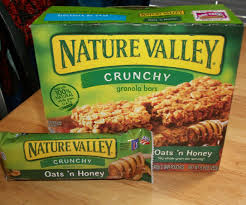 |
I decided to explore granola bars for my processed food because I often have it from my drawer as a togo snack. However, I've also heard a lot of rumors regarding its healthiness so I would like to learn more about it. |
(1) Are Granola a healthy choice for snacking? From this course, one of the things I’ve learned is that healthy can be interpreted in a different ways. For me, eating healthy means taking in all the essential nutrients for our body to function well. This means a good balance between protein, fat as well as carbohydrates according to lesson 1. Considering that granola bars contains all three nutrients, it could be a heathy choice. However, everyone has different intentions and if one is trying to lose weight for example, there may be better alternatives snacks because granola bars tend to be high in sugar. 2) What ingredients are there in it that benefit our body? In we learned to look at the nutrition labels. Based on the nutrition labels, Nature Valley granola bars have 190 calories. It is 100% whole grain oats! Making these bars richer in carbs with 3g of fat. A bar is beneficial is relatively considering that is is are low in saturated and trans fats. Also, from my group project, we focused specially on canola oil and this granola contains it. I have learned that till today it is still a very controversial topic whether it is healthy or not, so it does have its pros and cons. Lastly, the bars has additives again mentioned in lesson 4, which are used to retain the flavour of the granolas. 3) How/ why does it contain its shape? We did not directly talk about granolas but I guess from knowledge obtained from lesson 8, dehydration must be used in the making of granola bars in order for it to keep its shape. The nuts and oats in the bar must be dehydrated and then mixed together with other ingredients and pressed with a machine to make packaging easier. Also, the sticky substance like honey based on the ingredient list in this case, may also play a role to keep it intact. 3) Does granola bar contain at least 3 grams of fiber? Again from reading the nutrition label, I see the one bar only contains 1g of fibre! 4) How much total fat and saturated fat does it contain? The Natural Valley granola bar contains a total of 5% (3g) of fat but 0% saturated fat. Fats are macronutrients and according to the reading "Fats in the diet: Why and where?” from lesson 2, we learn that saturated fatty acid would have a maximum number of hydrogen bonded to each carbon atom. ) |
| (Insert Your WikiID) | thumb|(Insert Caption) | (Insert Answers) |
(Insert Response) |
| (Insert Your WikiID) | thumb|(Insert Caption) | (Insert Answers) |
(Insert Responses) |
Family Names that Start with 'J'
| Your Wiki ID | Photo of the Food | Option A: What happened? Option B: Why Did You Select This Food? |
Questions You Have |
|---|---|---|---|
| krysiacj | 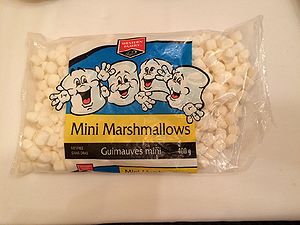 |
Over the past few years, I have more frequently incorporated marshmallows into my diet, whether is it for roasting them over a campfire or mixing them into hot beverages, such as hot chocolate. I have always been curious about the ingredients that are added and the processing steps that are required to make them. I believe that it is crucial to have a general idea about what you are putting into your mouth. |
1. What enables the marshmallows to become so foamy and spongy? Why do marshmallows quickly return to their original form after being subjected to applied force? 2. How are they made into the cylindrical shape? 3. What chemical reactions occur in the marshmallows while roasting them (exposing them to heat)? 4. What chemicals inside the marshmallows enable them avoid spoilage for a very long time? 5. Do marshmallows have some nutritional value? How much sugar is added in order to make a few mini marshmallows? 1. A solution is formed by dissolving sugar and corn syrup in water and boiling it. Egg whites and/or gelatin is mixed with the sugar solution. Then the ingredients are heated in a cook kettle to about 240°F (115°C). The resulting mixture is passed through a strainer to remove extraneous matter. Lastly, the mixture is then beaten into a foam to two or three times its original volume. 2.Marshmallows are extruded through a machine or deposited onto bands.The extrusion process involves the foam being squeezed through a die to produce marshmallow's familiar cylindrical shape. 3.A marshmallow undergoes a six-step transformation before it becomes a toasted marshmallow: (i) The swelling - as you heat the marshmallow, the moisture inside expands, which causes the marshmallow to swell. (ii) The escape - as the moisture expands, it creates tiny holes in the marshmallow, which allow the moisture to escape as steam. (iii) The sugar rush - as the marshmallow does not now have moisture, it is a sucrose char. Oxygen in the air rushes to the surface of the marshmallow. (iv)The flame on stage - oxygen diffuses to the surface of the marshmallow from the surrounding air. At the surface of the marshmallow, carbon reacts with oxygen, which produces a blue flame. (v) The oxidation stage - carbon atoms combine with oxygen atoms to produce carbon monoxide, and then carbon dioxide. (vi)The oxyinterruptus stage - as you remove the marshmallow from the fire and blow the marshmallow out, the oxidation process is interrupted, creating soot which is evidence of incomplete combustion: hydrocarbon + oxygen → carbon monoxide + carbon + water. 4. Marshmallows are able to stay in the shelf for long periods of time due their high sugar content. Sugar tends to draw water from the microbes by a process known as plasmolysis. This process leaves the microbial cells dehydrated, thus killing them. In this way, the food will remain safe from microbial spoilage. In general, marshmallows do not contain a lot of water. In addition, they get a coating of corn starch to help maintain their form after they have been extruded and to prevent oxidation reactions. 5. Added sugar increases the calorie content of certain foods. An excess of calories can contribute to unhealthy weight gain and obesity. Foods high in sugar are usually low in nutrition as well. When you eat large amounts of sugary foods, there is less room in your diet for fruits, vegetables, whole grains and lean meats, each of which supply essential vitamins and minerals. Marshmallows have virtually no vitamins or minerals, which makes them even less nutritious.If you use a cup of miniature marshmallows for a dessert recipe or eat this amount as a snack, you'll consume about 29 grams of added sugar. During the summer, I am planning to read the article " Methods and Machines for Manufacturing Marshmallows." ("Method and machine for manufacturing marshmallows, other confections, and food products." U.S. Patent 2,238,164, issued April 15, 1941.) |
| (Jeun) |  |
Option B: Whenever I have my soccer or ultimate frisbee games, I always pack one of these granola bars and I eat it between games or at half-time. It helps me stay energetic and focused. It’s also a great snack when you are feeling hungry during your study breaks or meetings. |
1. Does it contain all 9 essential amino acids? 2. Do granola bars expire? 3. What is the substance that helps the inside stick together? 4. Does it contain saturated fat or unsaturated fat? 5. How does chocolate affect the overall calories of a granola bar? Answers: 1. No. Because 9 E.A.A are found in different types of food. (Lesson 2) 2. The box indicates the expiry date as 'best before' but however, even if they don't expire, some companies choose to put it on. It is safe to eat them past their expiry dates, but it is advised not to if they have been passed for years. (Lesson 4) 3. Rice syrup or honey. Honey is commonly used a binder (Found on label and lesson 2& 4) 4. Saturated fats (Found on label and Lesson 2) 5. Chocolate has high calories so it increases the overall calories of a granola bar, providing us more energy. (http://www.healthaliciousness.com/articles/highest-calorie-foods.php) |
| (Rjammu) | 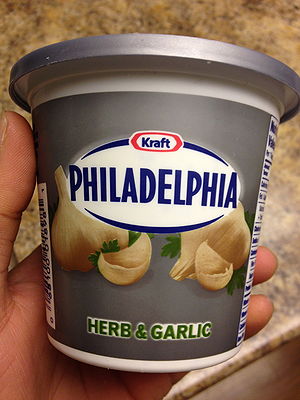 |
(Option B: I chose herb and garlic cream cheese as it is usually what I put on my bagels at breakfast. Normally, I am a healthy individual that watches what I eat. Several people have told me that cream cheese isn’t as healthy as it seems, and is more processed than it looks. Hence, I wanted to dig down and do research on a food that I eat every morning.) |
Answers: 1 Cream cheese is made via the process of fermentation. In Lesson 9, the fermentation of cheese is laid out in a step-by-step process. Although this is the general process for a variety of cheeses, cream cheese is still produced via this method. There are multiple steps that need to be followed in order to produce cream cheese (Lesson 9). 2 Because cream cheese is a dairy product, it needs to be refrigerated in order to obtain the greatest possible shelf-life. However, there are also some additives that are added to increase shelf life. Carob bean gum and Carrageenan are additives in cream cheese. Both are added as thickening, emulsifying, and stabilizing agents. This means that both of the additives will work to ensure that the emulsifications are maintained, ultimately increasing the shelf life of the product (Lesson 4). 3 When we look at cheeses, they don't all have the same texture (eg. brie vs. cheddar). The difference between the textures of cheeses is the fermentation process, and what additives are added to give it a certain texture. It isn't specifically stated in the lessons covered throughout the course, but I believe that the difference in fermentation processes as well as the additives used give the cream cheese its semi-solid texture. 4 The herbs and garlic used in the cream cheese are not fresh. When looking at the list of ingredients, it was seen that the herbs and garlic were dried prior to use. This can be attributed to lesson 8, where we learn that dehydration is a method of preservation. Because cream cheese is manufactured in large quantities, large quantities of herbs and garlic are needed. Hence, the ingredients are dried so that they are easier to maneuver, last longer (vs fresh ingredients), and still maintain the desired taste (Lesson 8 and educated guesses). 5 This question is similar to what was covered in assignment 2 in this course. With "light" or "low-fat" alternatives, there are usually more additives and artificial ingredients added to compensate for the decreased fat content. Overall, although the "light" or "low-fat" options may have fewer calories overall, it may be better to consume the original products. This is because they are more natural than the "light" or "low-fat" options (Previous work from Assignment 2 and lesson 4). |
| gagan900 | 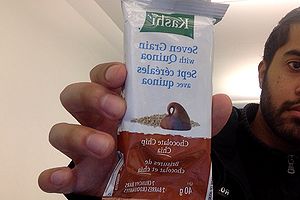 |
I selected this food because it is convenient snack that I sometimes bring to school and it tastes great. It contains seven grains and quinoa, so, I think that eventhough it is a processed snack, it is a healthier option than most bars you get from the market. I've been eating these bars for many years. This bar in particular contains healthy fats such as omega 3's and mono-unsaturated fats. |
(1)What makes the bar crunchy? the bar is crunchy due to the presence of hard ingredients such as grains compacted in a small bar. The ingredients include whole grain oats, chia seeds, whole grain blend (whole: barley, buckwheat, hard red wheat, rye, triticale and quinoa) which give the bar a crunchy texture. 2)what keeps the bar intact? Soy lecithin keeps a bar together by making sure that the cocoa (chocolate liquor in ingredients list) and the cocoa butter don’t separate. Also, the company says they use guar gum which is natural ingredient is made from the hardened sap of the acacia tree; it helps stick ingredients together. 3)why is soy lecithin added? Soy lecithin possesses emulsification properties; it can keep a bar together by making sure that the cocoa and the cocoa butter don’t separate. 4)what is fancy molasses? Fancy molasses is a viscous by-product of the refining of sugarcane or sugar beets into sugar. When making sugar from sugar cane, fancy molasses is the dark liquid left after removing sugar from the cane juice. 5) Why was this added? Fancy molasses is added to impart feeling of sweetness to the food. |
Family Names that Start with 'K'
| Your Wiki ID | Photo of the Food | Option A: What happened? Option B: Why Did You Select This Food? |
Questions You Have | ||||
|---|---|---|---|---|---|---|---|
| EunJoongKim | 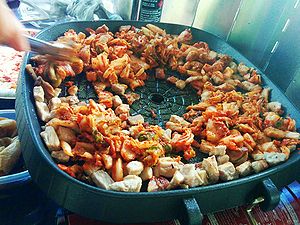 |
A. When my family was still back in Korea, my dad went out with his coworkers to have a dinner after his work. He had pork belly and drinks, typical Korean dinner with colleagues. He came back and took a shower, and noticed some rashes around his neck. After an hour or so, the rash started to spread and he was having a hard time breathing. He went into the emergency room and was told he was allergic to pork fat. He was given medicine and since then avoids any kind of pork. |
Q: Pork belly is one of the most popular dish in Korea, and it was not my dad's first time eating it. He wasn't sick or anything on that day. Why is he suddenly allergic to it? A: In our class we did not discuss the reasons behind allergens. Hence I've found a link that briefly talks about the reasons and symptoms of pork allergy. http://www.activeonehealth.com/viewarticle.php?artid=5 | ||||
| Michelle Kim | 
|
Option B. My friend spent a weekend at an university club retreat, where an excess of alcoholic beverages were consumed. The Monday after that weekend, we were attending the same class when he started complaining about being itchy. Turns out he had broken into pretty intense hives all over his body (except the face). The hives/rash lasted a good week, before they eventually faded away. He was not able to do anything except wait for the allergy symptoms to fade. |
1. My friend can tolerate a certain amount of alcohol without getting an allergic reaction, it only happens once he drinks over a certain amount-why? 2. I have heard that this is more of an intolerance than an allergy, is this true? If so, why did my friend break out into hives? 3. How does alcohol affect the body? Questions 1-3 was not discussed in much detail because it focuses on the health effects of alcohol on the body. There is plenty of information on health related affects of alcohol, as it is a common condition. This website goes into plenty of detail regarding alcohol intolerance; http://www.mayoclinic.org/diseases-conditions/alcohol-intolerance/basics/definition/con-20034907 4. How is alcohol made? Yeast is used as a fermentation agent to convert glucose (and other carbohydrates capable of fermentation) to ethanol. It is then further pastuerized and filtered as preservation methods. This can be found in Lesson 9. | ||||
| jlkwong | 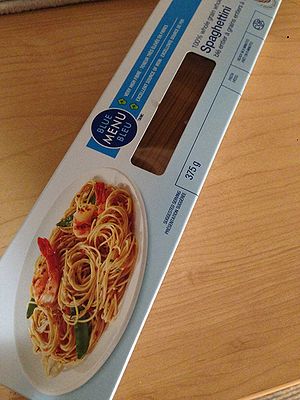 |
Option B. I oftentimes cook spaghetti, or even any type of pasta noodles for dinner because they are quick and easy to make. There are also so many different types of pasta recipes, which helps keep this easy meal interesting at the same time! |
1. How is wheat processed in order to make spaghetti noodles? 2. How is it that the noodles turn soft after cooking them in boiling water after a few minutes? 3. How are regular pasta and whole wheat pasta processed differently? 4. Once cooked, what gives pasta its soft and chewy texture? 5. Why is it that the uncooked noodles can be kept for a long time without going bad? A) Pasta is made from a mixture of semolina flour and water. Eggs and Vegetable juices are also sometimes added for texture/colour. First, machines mix water and semolina flour together. Next, the supplementary ingredients are added (Egg/Vegetable juice/Spices). The dough is then flattened and then pasteurized to get rid of contaminants. In the final processing stages, the dough is cut accordingly, depending on the type of pasta being made. Lastly, the freshly cut pasta is dried in a controlled environment (since drying can impact the quality of the pasta) and is packaged into containers. (McNulty, M. (2015). How Products Are Made. Retrieved April 18, 2015, from http://www.madehow.com/Volume-2/Pasta.html) B) For the second question, I recall in lesson 8 that we briefly talked about rehydration during our discussion on dehydration processes. Some reasons why pasta noodles are dried is that it serves to preserve the product. The water is removed, causing the product to be more ideal for storage. However, when products like pasta are placed back into hot water, rehydration occurs. This causes the noodles to turn soft and to restore their original shape. However, the notes in lesson 8 did mention that food products that are dehydrated sometimes lose their ability to rehydrate as well, due to the loss of water soluble substances. (Chan, Lesson 8) C) I do not recall discussing question 3 in class. However, I did some research and learned about the different layers of grains. All grains before they are processed (milled) have an outer layer of bran, a middle endosperm layer and an inner layer called the germ. During milling, the bran and germ layers are removed, leaving only the endosperm. These removed layers are nutritious. In whole wheat products (like pasta), these layers are not removed, which is why there are health benefits with consuming whole-wheat products. (Curinga, K. (2014, January 19). Whole-Grain Pasta Vs. Regular Pasta. Retrieved April 18, 2015, from http://www.livestrong.com/article/316054-whole-grain-pasta-vs-regular-pasta/) D) Pasta is a starchy product. According to our discussion in lesson 2, starch granules are not soluble in cold water, but will be if the water is heated. When the starch absorbs the hot water, gelatinization occurs, causing the food product to become more soft and pliable. This explains why pasta has a soft and chewy texture when it is cooked in boiling water. (Chan, Lesson 2) E) As mentioned earlier, pasta undergoes a process of dehydration. Pasta and other dehydrated products related to pasta are known to have a long shelf-life and this is partly due to their dehydrated state. Microbial growth on food products depends on the amount of free water available. Since the amount of free water is decreased during dehydration, it discourages microbial growth and thus, pasta can be stored for long periods of time. (Chan, Lesson 2) |
AlfredKe | 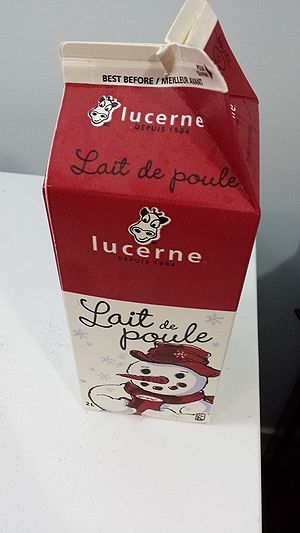 |
Option A. I love eggnog and I tend to drink a lot of it at home every winter. Occasionally, I would get stomach aches and in a worst case scenario, diarrhea, if I drink too much eggnog. The easiest way to resolve this was to stop drinking eggnog for a while and let the eggnog pass through my body before I drank more of it. |
Seeing as I'm not lactose intolerant (or at least I've never noticed with any dairy products besides eggnog), why do I get sick from drinking too much of it? Would I get sick if I drank too much 2% milk? Assignment 3 answer: I've found out that I might have a mild version of lactose intolerance. I may have the enzyme lactase to break down lactose but not enough to handle large quantities of dairy products. I would also get a stomach ache and diarrhea if I drank too much 2% milk as well. Answer from http://www.webmd.com/digestive-disorders/diarrhea-lactose-intolerance-when-dairy-is-problem |
| ChristopherKwok | 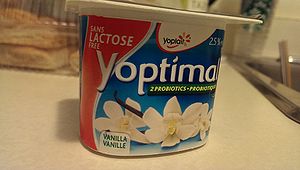 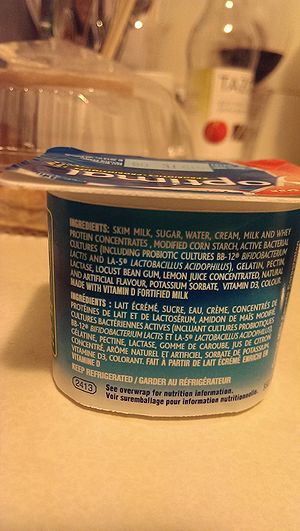 |
Option B. I love consuming dairy products; Ice cream, Cheese, Yogurt, Milk, etc. But I am slightly lactose intolerant, sometimes i get a tummy ache drinking milk, other times i dont, but that wont stop me from continuing to eat it! |
Shown here is a typical yogurt I consume daily, It is labled as Lactose Free, but what exactly makes it lactose free? For those who are lactose intolerant like myself, can we consume this product without problems? Why is Lactase an additive ingredient? Is it there to help those who are lactose intolerant to digest the yogurt, therefore it is Lactose free? Too many products on the market are labled as Organic, Fat Free, etc. But what exactly makes them so? | ||||
| AndrewKanerva |  |
Working at Cactus Club, I now know how to make their Schezuan chicken lettuce wraps. Thai sweet chilli sauce is an important ingredient in the dish. Schezuan lettuce wraps have become one of my favourite dishes to have at home and if you've tried them, you'll know why. |
What role does the Acetic acid E260 play? We did not talk specifically about acetic acid E260. How ever, acetic acid was. Acetic acid was spoken to as compound contributing to the aroma of coffee in lesson 2. In lesson 3, I learned that acetic acid is the main constituent of household vinegar. After researching acetic acid on Wikipedia, I learned that E260 is an approved food storage component. it adds to the acidity of food. I lesson 5, I learned that acetic acid is used in food preservation as it can alter the pH to bring pH to the critical value to microbial growth, 4.6. How is that sweet taste achieved by using chilli's? Taste profiles were not covered in class so much as food preservation and food safety was. It is, how ever, interesting how a sauce/condiment with its main ingredient as chili’s can have the sweetness it does. The making of a sauce/condiment such as this requires the cooking and reduction on the ingredients. This means that as the ingredients are cooking together, the flavor profiles of the ingredients will enhance and become more concentrated. Although the chili’s add an aspect of spice, there is naturally sourced sugar. When reduced this sugar will come in to play. As well, chili sauce is made with sugar and some times even corn syrup. The sugar and corn syrup will definitely add an aspect of sweetness in the reduction process of making the sauce. Is salt the only active preservative? No. As mentioned above, the acetic acid will act as a preservative, which was discussed in lesson 5. As well, the sugar in chili sauce will act as a preservative. In lesson 5, I learned that sugars and salts are used to lower the water activity of the food product. In doing so, preventing microbial growth. As well, sugar is used in jams and jellies not only for its sweet aspects but for its ability to cease microbial growth. | ||||
| SuMeeKim | [[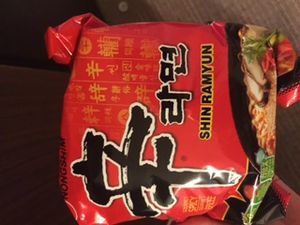 |
I chose this Korean instant noodle because I eat this at least three times a week which is more often than any other food I eat. I am an international student living alone in Canada so although I would like to cook more often I tend to depend on these instant noodle more often than I want to because it is easy and quick. Back when I lived with my parents before coming to university, my parents never allowed me to eat instant noodle so instant noodle and they always told me that it's very unhealthy. |
1. Is instant noodle really as unhealthy as my parents describe? They tell me things like the instant noodle powder is actually very irritating to the stomach and that the noodle is fried in low quality oil. 2. Why do instant noodle have long shelf life? Does it contain a lot of preservatives? 3. What would be the difference between instant noodle that is in a packaging like in the photo (to boil) and instant noodle that is in a cup (to pour in hot water)? If there is a difference, which is less unhealthy? 4. Is the power in instant noodle actually all made of natural ingredients or mixed with chemicals that stimulate the taste buds? 5. I have seen friends eat instant noodle raw without boiling it in water. They just break the noodle in to small pieces and shake it with the powder and eat them like chips. Although instant noodle does not contain anything that would go bad when eaten dry, is eating it raw more unhealthy than eating it after cooking? A |
Family Names that Start with 'L'
| Your Wiki ID | Photo of the Food | Option A: What happened? Option B: Why Did You Select This Food? |
Questions You Have | |
|---|---|---|---|---|
| MatthewLaw | 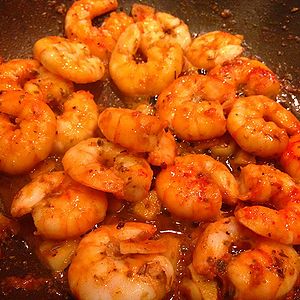 |
In 2012 winter, my family and some relatives went to have hot pot together. In the hot pot there are any types of sea food including shrimps. After thirty minutes of having hot pot, one of my relative started having rashes and red dots on his face, hands, and other parts of the body. He is feeling very uncomfortable. Since his situation is getting worse and worse, our family decided to bring him to the hospital. He was then diagnosed with seafood allergic reaction. The doctor gave him some medication and after a few hours, he returned normal. |
| |
| TerryLok | 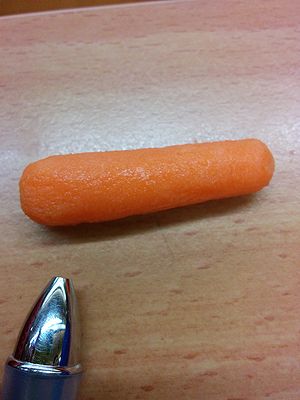 |
In the summer of 2013, Golden Ears Park, my friends and I were camping and we left baby carrots out on the picnic table for the whole duration of the trip and decided to continue eating the opened package of baby carrots on the way back. Our stomachs were knotted and had to stop at multiple gas stations on the way back home. The baby carrots may have gone bad due to the bacteria accumulated over several days. It was not a pleasant experience and eventually we slowly recovered. |
For question #1, baby carrots were not specifically studied in FNH 200. I expect them to have been sanitized using chemicals such as a little chlorine prior to being sold. Upon further research, baby carrots are just cut and peeled larger carrots. "Design Your Life: The Pleasures and Perils of Everyday Things" is a book by Ellen and Julia Lupton has information about how baby carrots are made and I can read this when I have time after exams. 2. In fact baby carrots are not harvested pre maturely but they are full grown carrots that are peeled and cut smaller. This was not covered in FNH 200. 3. Baby carrots from my research has chlorine added to sterilize them but as well, according to Lesson 6, the carrots may be blanched prior to being packaged to inactivate enzymes that may cause degradation of the carrot. 4. From a few websites, the left over cuttings from making baby carrots are fed to livestock thus is sustainably recycled. This is not a topic in FNH 200. 5. In Lesson 6 again, we can use high heat prior to consumption to kill the "ugly" microorganisms that can cause food born illnesses but the microorganisms that cause food spoilage should be taken care of prior to being packaged. 6. There is an expiry date on the carrots which means it should expire within 90 days. This is pretty obvious as vegetables do not have long shelf life. The carrots are usually also packaged in a vacuum sealed package to control the amount of oxygen in the package.This will help prolong the shelf life of the baby carrots. Keeping the carrots in the refrigerator will help slow the growth of potential food spoilage bacteria but will not kill them according to Lesson 7. | |
| KarenLee | 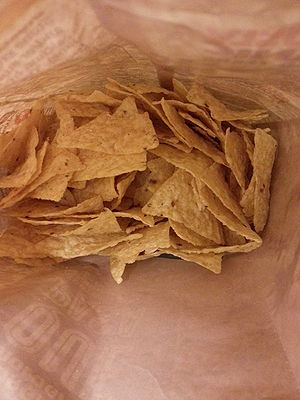 |
One of my favourite party snacks is having tortilla chips along with dipping sauces such as salsa or hot cheese. I want to know what makes them so desirable despite their healthy claims on the packaging. |
For question #1, we have learned that chips need to be dehydrated as one of its preservation methods. It could be tray dried or deep fat frying dried (Lesson 8). Question 2: We did not discuss organic and GMO foods. Information on GMO and organic foods can be found on the Canadian Organic Growers website at http://www.cog.ca/index.php?page=consumers-and-standards. This website can help us understand the processes and standards required for food products to be labelled as "organic" or "GMO-free". These chips are also listed as gluten-free, something we briefly learned was part of the structure of bread (Lesson 2). Question 3: Like with any food, it needs to be consumed in healthy moderation. Because tortilla chips are not a naturally grown crop, they need to be synthetically created, as part of a food science investigation (Lesson 1). Question 4: Because dehydrated foods have low water activity, they are hygroscopic, meaning they easily pick up moisture from their surroundings (Lesson 8). As a result, the expiry date on the tortilla chips are due to packaging materials being open, exposing the tortilla chips from their sealed packaging, transmitting the water vapour from the air into the food and causing staleness (Lesson 8). If the chips have an expiration date, this means their shelf life may be under 90 days (Lesson 4). Question 5: It is likely that the optimal size of tortilla chip is one that can maximize dehydration rates without over or under dehydrating the product. This is determined by the method of dehydration and the type of packaging that will be used to contain the tortilla chip, which is likely a sealed packaging that prevents moisture from entering (Lesson 8). | |
| JiakaiLiang |
 |
I am a huge fan of Japanese food and my favourite is sushi. Sushi is a combination of creation and delicacy, which drives me crazy every time I have it. Needless to say, it also represents Japanese culture and it's hard for people to hate it. More importantly, I can always access it in the fridge of grocery stores and I don't have to cook it anymore. |
| |
| Timothy Lau | 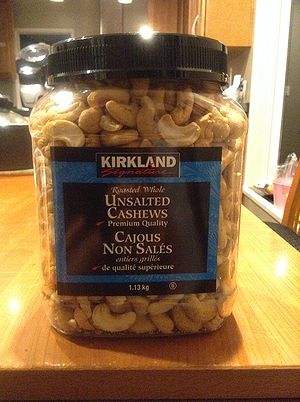 |
1. On a cold Winter day back in grade 12, I had a scary encounter with a certain food: anaphylaxis. Ever since I was a little baby, I've been allergic to peanuts. This was my first case of anaphylaxis since the very first time I tried something with peanuts, when I was only a couple of years old.
2. I enjoy eating nuts - just not peanuts. This includes my favourites like almonds, brazil nuts, and cashews. The night before I packed my lunch and snack, I saw a container of Kirkland cashews in the cupboard. So, I packed some in a container for the next day, not realizing that the only two ingredients in this are cashews and PEANUT OIL. My reaction affected many people. Obviously, my family was affected the most. My blunder in not checking the ingredient caused worry between my Dad, Mom, Brother, and Sister. My grandparents, aunts/uncles, and cousins were all worried as well when they heard of the incident. Among the others that were affected were my friends at school who saw me carried out on a stretcher and into an ambulance, as well as the school nurse, paramedics, and doctors who treated me. The symptoms of anaphylaxis include sweating, dizziness, stomach aching, constriction of airways, and throwing up. All of these were not pleasant, especially the latter. The throwing up caused a tear to my abdominal muscles, which were painful for the next few days after the incident. It happened when I was in grade 12 (16 years old), in December of 2012. Luckily, it happened at school, where there was a nurse present. I did not carry an EpiPen because of the lack of serious cases of allergic reactions to peanuts in the past. I am extremely thankful this happened at school, instead of for example, when I'm driving by myself or walking by myself. The nurse gave me to EpiPens, and the epinephrine immediately helped. The paramedics gave me a third dosage of epinephrine, and at the hospital, I was given even more drugs/steroids. By the time I was at the hospital, the situation was pretty much resolved, due to the high amount of epinephrine I had received. I did not have to stay the night at the hospital. |
3. Apparently, if I understood from the doctors correctly, that I had grown even more allergic to peanuts over my time. I never really understood this, and I wonder how this can happen. Lastly, why does Kirkland have to coat their cashews in peanut oil?! :( Answers: Unfortunately, not much was covered regarding allergens. However, as eluded to in Lesson 13, allergens are natural constituents as toxins and can have varying levels of risk to certain people. Peanut oil was probably used to increase the desire of the cashews, which we explored in Lesson 2. Firstly, knowing that peanut oil is fat, it acts as a lubricant and therefore makes the cashew easier and more desirable to chew and swallow. In addition, fats carry aroma constituents that contribute to the overall flavor of food – as we learned, taste + smell = flavor. Peanut oil is high in polyunsaturated fats and very high in monounsaturated fats. As learned in the Lesson 2 reading ‘Fats in the Diet: Why and Where’, monounsaturated fats have one double bond in the fatty acid chain, where as polyunsaturated fats have two or more double bonds. Polyunsaturated and monounsaturated fats have their own respective health benefits (beyond this course), hence, another possible reason why the cashews were coated in peanut oil. Because I could only answer one of my questions, I will answer a food-science question that I wondered during this semester. That is, how are oils from nuts/vegetables extracted from the raw product into oil? After doing some research, I learned that vegetables are first heated so that a solvent (often n-hexane) can freely enter the cells and remove the oils Two other methods, called percolation and immersion, are also used, although are more complicated and are used when the oils are harder to extract. Source: http://gustavheess.de/index.php?option=com_content&view=article&id=58&Itemid=84&lang=en | |
| MelodyLee |
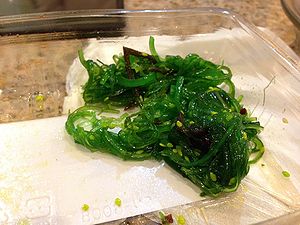 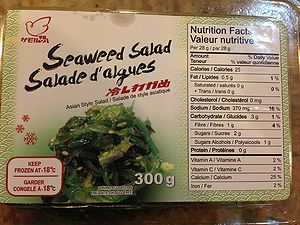 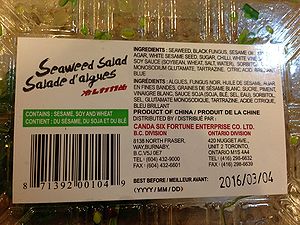 |
I selected this food called seaweed salad because I only recently tried it for the first time. I was a little skeptical at first since it looks very unappealing. Despite the looks, it actually tastes really good. I also chose this product because I do not know much about seaweed other than it is an important nutrient for the body. |
1. How do you make this? 2. How are the seasoning made and chosen? 3. Why does it last over one year? 4. Why should it be kept in the freezer? 5. Seaweed is known to be healthy, but is this product beneficial for the body or the opposite? For question number 1, I researched how this is made and surprisingly, this particular version of seaweed salad is not made in Japan however it originates from China. I did find out that it is made with wakame (seaweed) stem and a seaweed based gelatin substance called agar-agar as well as added seasonings such as sesame oil, sesame seeds, chili, soy sauce and others according to the ingredients listed on the packaging. The standardized food vinegar (Lesson 4) is also listed as an ingredient that produces sour taste, which is due to acetic acid (Lesson 3). Question 2 asks how the seasonings are made and chosen. The seasonings ultimately add and enhance the flavour of the seaweed salad. The seasonings are most likely chosen to create a unique flavour and appeal to consumers. Question 3 addresses the date of expiry. This product lasts over one year because of the preservation method of freezing. Freezing allows the nutrient content to be closest to the natural and raw form. Questions 4 also relates to storage. As said previously, the freezer method minimizes nutrient loss during storage and preserves the product as well (Lesson 11). The low temperature of the food decreases the rate of enzymatic, chemical and microbial reactions in foods and therefore extends storage life (Lesson 5). The seaweed salad is also packaged in a plastic box to withstand the freezing temperature of storage. Lastly, question 5 presents the health benefits aspect of seaweed. Searching through multiple sites online, seaweed is high in protein, high in mineral content namely iodine, calcium, iron, magnesium and consists of vitamin C among other benefits[4]. Iodine is especially important because it contributes to a healthy thyroid function [5]. The variety of health benefits related to seaweed is clear although multiple ingredients added to this product perhaps degrades the healthy element. This may be so because sugar, sesame oil, soy sauce (soybean, wheat, salt, water), monosodium glutamate (MSG) and tartrazin are ingredients in this product which may alter the seaweed ingredient. MSG contributes to the umami taste receptor that enhances taste sensations (Lesson 3). We have not talked about seaweed in class and perhaps it may be a new food to explore in the future. | |
| Sze Yiu Li | 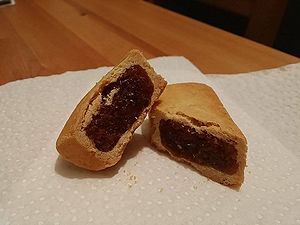 |
My roommate is running a business. She buys pineapple cakes from Taiwan and then sells them in Vancouver. There are many boxes of pineapple cake in our room. I wonder why so many people would like to spend 20 dollars on a box of pineapple cake. |
Answers: Question 1, pineapple contains Xanthophyll, which is classified in Carotenoids, produce yellow color pigment. For the artificial color pigment, however, I think the processors would add certain color pigment to enhance the aesthetics appeal. (Lesson 2) Question 2, pineapple cake can be classify as dry snack food that is semi-perishable food. When pineapple cake is baked, the high temperature is able to kill some of the bacteria that can be killed in the range from 82 degree Celsius to 93 degree Celsius. Also, sugar would be the major ingredient of pineapple cake, sugar with high concentration would bind water and present dehydrating effect to prevent growth of bacteria and yeasts. Furthermore, the atmosphere might be controlled during packaging. Last but not least, processed pineapple cake would be packaged with antimicrobial agents. (Lesson 5) Question 3, I don't think pineapple cake contains genetic modified organism. However, I am not sure whether the genetically modified pineapple would be used as the ingredient in the cake. I will get more information from this website, 1)http://www.gmo-compass.org/eng/database/plants/17.pineapple.html 2)http://en.wikipedia.org/wiki/Genetically_modified_organism Question 4, browning reaction occurs during baking. Also, protein denaturation and coagulation would be the chemical reactions that occur during processing pineapple cake. (Lesson 2) Question 5, Sucrose, table sugar, is a common carbohydrate that would be used to make desserts. (Lesson 2) |
|
| Kari Lindberg | 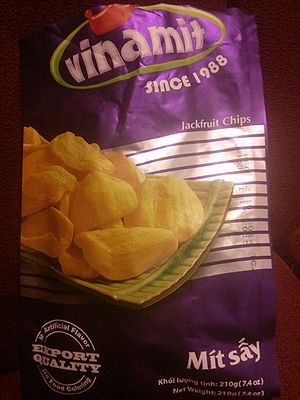 |
I have always found jackfruit to be a most delicious, yet particular type of fruit, tasting of banana and strawberry all at once. Natural to South East Asia, it is always a fruit that has the instant ability to trigger happy teenage memories. Out of my strong emotional attachment I wanted share this with the class. |
Jackfruit chips are created through the process of tray air drying, where their “chip” like qualities are the result of case hardening is the result from the sugar compounds forming a hard durable case around the fruit. Potato chip are dehydrated through the process of deep fat frying, where high temperatures of hot oil cases the water in the food to be evaporated. Rapid evaporation along with oil that the potato has absorbed results in the potato being dried (Lesson 8).
| |
| joshling |  |
I am always tired in the morning and need some way to keep myself awake in the early morning classes that I have. Coffee helps me stay awake and keeps me alert enough to take notes in classes. I also chose this item because I think I am slightly addicted to caffeine itself. |
Answers: 1.In this class we did not talk about the affects of caffeine or what coffee is made of other than just the beans. I believe it is the caffeine that keeps me awake after studying some of it's properties in other classes but I could further my understanding by reading this article from livestrong.com http://www.livestrong.com/article/492508-can-too-much-sugar-keep-me-awake/ 2.FNH 200 taught me many ways of drying foods to preserve them in lesson 8, but we did not touch on the subject of roasting and how it may affect the product. In many ways, roasting is similar to sun drying but at a higher temperature and mechanical. In the case of sun dried tomatoes, drying it increases the intensity of the flavor so I believe that roasting the beans would increase the flavor but will not affect the potency of the coffee. 3.In lesson 11 we learn about nutrient loss in processing. We did not specifically talk about how much processing occurs in coffee. However, from the lesson, I learned that no matter the method, there will be some loss of nutrients in the product. To learn more about what happens to coffee before it gets to us in a cup I can watch a "How it's Made" video on coffee. https://www.youtube.com/watch?v=DYsWECLaakI 4.Each coffee company is bound to have their own secret recipes and to really find out what else is added to the coffee that makes it taste so good would require the specific ingredient list from the company itself. In lesson 3 we discussed about favor and especially focused on sugars. It could be possible that the companies are added their own types of sugars or other additives to change the flavor so that it is more potent or more smooth. 5.Coffee in moderation, much like many other foods, is believed to be good for you since a small amount of caffeine provides you with a slight boost of energy. It is also on the acidic side when it comes to pH but nowhere near acidic enough to harm our bodies just by drinking it. As we talked about in lesson 2, I am certain there are many additives in coffee like antioxidants and added nutrients. However, I know that I do not need to worry much because as I learned in lesson 4, there are health regulations that must be followed in order for a product to be allowed to sold in Canada. | |
| Yuling Li | 
|
A:
Although I was not a persimmon lover, in 2006 I tried this dried persimmon under my mom's huge recommendation. Upon the second bite, I could hardly swallow cause I got edema from mouth to throat. It was so severe that I end up with literally sausage lips for half an hour...By the way,no one else showed any symptom after eating those dried persimmon, so I guess l am specifically allergic to them. Probably this allergy accident would not be forgotten forever~ |
| |
| Zahra Lakhdhir | 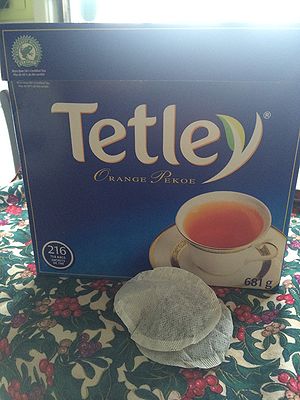 |
Black tea has been an essential part of diet for the better part of the last ten years. I cannot go a day without drinking at least a few cups of tea. Not necessarily for the caffeine, but just for the pleasure of enjoying a cup of tea. |
| |
| Wesley Livermore | 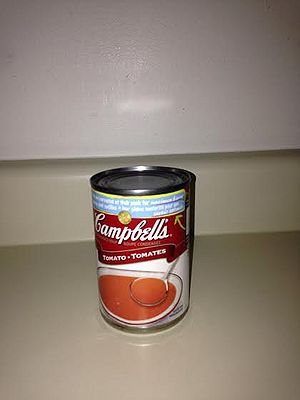 |
Tomato soup is delicious! Especially when you are sick, which is precisely why it is in my cupboard and has been the chosen one. |
A: My guess is only 1-3 real tomatoes. As we learned, this product is probably processed with other pastes.
I'll have to guess no. Rice needs a serious amount of time to be cooked. It is not the amount of boiling but rather time.
Although I am not sure what it's direct competitors health stats are, I can safely say none are probably good for you.
Funny enough, I found out I actually enjoy cherry tomatoes! The reason why I enjoy this soup and not real tomatoes is because of the processing and other ingredients involved.
I would hope somewhere locally. However, by this product being canned, I seriously doubt it was made anywhere locally. | |
| AnhLe | 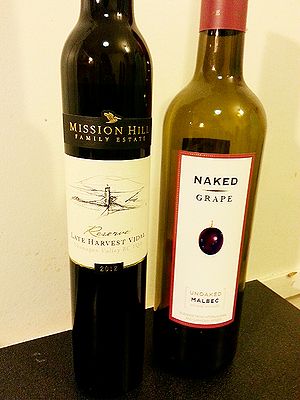 |
My father and I share a common interest in wine-tasting and thus this particular drink plays an important role in our bonding time.
My love for wine is also one of the reasons I chose Food Science as my major and thus this is the perfect opportunity for me to express my interest in this amazing and healthy (if consumed in moderation) beverage. |
| |
| Hwang Lee | This is the one of my favorite instant noodles. This noodle is extremely spicy rather than other instant one, but taste is as good as its spicy.
To people who are not good at eating spicy foods, trying this noodle can be a torture for them. |
|
Family Names that Start with 'M'
Family Names that Start with 'N'
| Your Wiki ID | Photo of the Food | Option A: What happened? Option B: Why Did You Select This Food? |
Questions You Have |
|---|---|---|---|
| James Mackin | 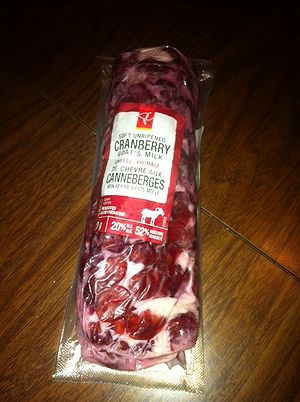 |
This is soft, unripened goat cheese, that has been wrapped in cranberries. It's tasty. |
1. What is the difference between unripened and ripened goat cheese? Unripened cheese is fresher, with minimal processing. Ripened has a lower moisture content, and tends to have a creamier colour, as opposed to the whiter colour of unripened. 2. How is ripened goat cheese processed? A fermentation process is used, similar to that of Camembert or Brie. 3. How is unripened goat cheese processed? Essentially, the goats milk is turned into cheese, much like any other cheesemaking process. That is the end of processing for unripened goat cheese, it would undergo fermentation in order to become ripened. 4. Do the cranberries go through any processing? The cranberries are dried, and a small amount of sugar is added to them, but otherwise, they are just placed on the goat cheese. 5. Exactly how healthy is this? As far as dairy goes, this is relatively healthy. It should be eaten in moderation, as too much of it could possibly lead to an increase of weight. |
| Pablo Madrigal | 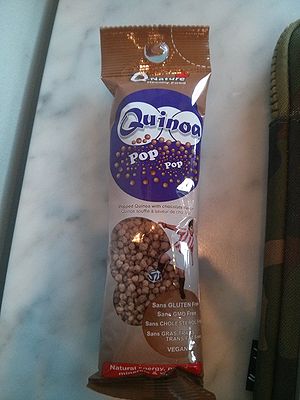 |
This is popped quinoa with chocolate flavour. I chose this snack because I'm a vegan and this is a really convenient way to add some protein into my diet when I'm at school or travelling. |
1. How do they 'pop' the quinoa? We never discussed the process of "popping" in the course but quinoa, much like corn kernels, can be exposed to high heat levels and essentially become "puffs" by this method. 2. How do they incorporate the chocolate flavour? My guess is that while the quinoa puffs are being processed, they go through some type of conveyor belt that exposes them to some sort of procedure that incorporates cocoa powder into the quinoa puffs. I sat this because the products are not covered in a creamy chocolate mixture, so the chocolate flavour must come from powder. 3. What properties of the grain change when you pop it? As we learned in lesson 6, when foods are exposed to high levels of heat, they suffer a loss in their nutritional value. Quinoa grains are no exception, however, as with popcorn, the majority of the nutrients remain. 4. Is it healthier than cooked quinoa? There will some loss of nutrients in cooked quinoa as well because of the cooking process in boiling water, however, we didn't really discuss this in class, but vegetables that are not raw maintain the majority of their nutritional value when they are steamed. I suppose that with grains is the same. The quinoa will keep a larger amount of amino acids and it will be more satisfying and filling that popped quinoa. This is because the consistency of popped quinoa is light and airy whereas steamed quinoa resembles that of rice or pasta. It will be heavier and it will fill you up. 5. quinoa is a source of Lysine. Why is it important to incorporate Lysine into our diet? We didn't cover lysine specifically to a great extent in his course, but Lysine is an amino acids. We learned in lesson 2 that proteins are one of the macronutrients that are necessary for our health and development as human beings. Proteins are essential for the development, maintenance, and increase of muscle mass. Quinoa is great source of plant based protein if you are a celiac, and cannot consume gluten, or if because of one's dietary choices such as being a vegetarian or vegan. |
| Kaycee Morison | 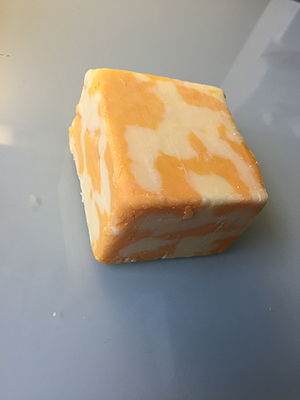 |
I selected this food because cheese is a predominant part of my diet both by itself and in an assortment of foods. I like how cheese comes in a variety of flavours and can essentially be eaten at every meal. Because I consume cheese regularly, I would like to know more information regarding its storage and its expiry. |
1. When part of the cheese is mouldy, is it safe to consume the non-mouldy part? 2. How long does it take to produce cheese? 3. If milk upsets your stomach, will cheese too? 4. What factors determine the hardness of cheese? 5. What is the best method to store cheese? 1. In Lesson 5 we learned that microorganisms could be classified into three types: the good, the bad and the ugly. Fermented foods such as cheese are an example of the good type as microorganisms are key to the production process. When cheese has been improperly stored or has reached the end of its shelf-life it will begin to spoil and mould may begin to grow. As we learned in lecture, the type of cheese affects whether or not it is safe to consume the non-moldy part. If the cheese is a harder variety such as cheddar cheese for example, it is safe to cut off the mould and consume the rest. With this being said however, if the cheese is softer such as Brie for example, all of it must be thrown out. This is because in soft cheese, mould can penetrate and spread throughout the cheese more easily. 2. As we learned in Lesson 9, the production of cheese is a fairly long and complicated process that falls under the umbrella term of biotechnology. To begin, lactic acid-producing cultures and colouring are added to pasteurized milk. Once the milk has turned acidic, rennet is added, causing the caseins found in the dairy to coagulate. From here, the curds are cut into cubes and then cooked at a temperature of 38°C. Next the curds are left to sit and the whey is drained. When this is complete, the cheese is salted, pressed and then finally left to ripen in a cool room for a time period of 3-4 days. As we learned in lecture, the total time needed to produce cheese is approximately 4 days. 3. In Lesson 2 we discussed food allergens in Canada. According to Health Canada’s website, milk is considered to be one of the top ten priority food allergens in Canada today. As we learned in lecture 2, people that have difficulty digesting milk are often lactose intolerant. This occurs when a person does not possess the enzyme lactase, which is necessary to breakdown lactose and therefore, will often experience minor cramps, bloating or diarrhea when lactose is consumed. Sometimes people who have trouble digesting milk find that cheese can be easier to digest, especially cheeses that have been aged such as Swiss or cheddar cheese. As this truly depends on each individual case, the only way to determine if cheese will upset one’s stomach is by trying it and getting tested by a doctor to see if you are lactose intolerant. 4. In Lesson 9 we learned that cheese could be classified as soft, semisoft, hard, very hard, processed and whey. These variations stem from differences in the processing. These differences are dependent on the starter culture used, the type of milk used (whether it is goat, sheep or cow) and the type of bacteria that is used in the fermentation process. In general, acid coagulation results in softer cheese, while rennet-based coagulation results in firmer curds and ultimately harder cheese. 5. In Lesson 5 we learned that cheese must be refrigerated in order to delay the growth of acid-tolerant psychrotrophic moulds. The storage of dairy products such as cheese is maximized when the food is stored in a temperature that is equivalent to 0°C. In general, the lower the temperature that cheese is stored in, the slower the rate of enzymatic, chemical and microbial reactions. As well as this, it is important to make sure that cheese does not experience changes in water activity, deterioration due to oxidative reactions or physical deterioration as any change could lead to a decrease in quality. In Lesson 5 we learned that some cheeses are considered to be semi-perishable foods and therefore could have a shelf-life of 2 to 6 months. |
| Mahboobeh Mohebkhah Siahmezgi |  |
There is no thing such as wild broccoli. As a biologist who is aiming to do her second degree in food science, I have always been interested in man-made food and its impact on human health. Actually, It was a huge shock when I was told that broccoli was first introduced in the Mediterranean almost 1,000 years ago and was not being used in US till 1920s. But don’t worry, broccoli is not a GMF. Broccoli is a human innovation, a man-made food, and a result of a mutation selected and cultivated by man throughout history. |
1. How do scientists distinguish between GMF and the selective propagation of naturally occurring mutations ? 2. Are there any other kind of hand-made foods out there? Is it a long list? 3. Is it healthy to eat hand-made foods?Is there any side effects? 4. Is there any advantage for eating GMF? I mean anything beside that it fits our taste and needs? 5. What percentage of what we eat now is the product of very easy to hybridize native plants?Maybe it is scary to know the real answer. 6. I come from Iran and since I just moved to Canada, I can still compare the taste of foods. Why do I feel foods and vegetables are more flavored in my country.?I heard this also from one of my American friends who is doing his internship in middle east. Is it because of the climate or maybe the fruits and vegetables are being altered here and this is a trade off to get a better look and size? 1.Answer:GMF is genetic engineering and scientists move or re-organize the genetic material in the cell but in elective propagation simply they choose the plants with better traits and breed them to get better quality products 2.Answer: Yes, there is a log list and a lots of foods we are eating are GM. You may do not know but 90%of canola oil we consume is GM. 3.Answer:It can be unhealthy. Genetically modified (GM) food can leave material behind inside us, possibly causing long-term problems. Genes inserted into GM soy, for example, can transfer into the DNA of bacteria living inside us, and that the toxic insecticide produced by GM corn was found in the blood of pregnant women and their unborn fetuses 4.Answer: it is much of it. It fits our needs and taste.We can feed the world with GMO. However,the genetic engineering of plants has the potential to provide edible plant vaccines that could be used to immunize individuals against a wide variety of infectious diseases ranging from cholera to potentially AIDS. 5.Answer: I couldn't find an exact number for it but through my reading, I understand that it is unfortunately a large number. 6.Answer: It is a combination of both climate and alteration. Since here, even organic foods are being modified by applying selective propagation of naturally occurring mutations. The better look fruits are selected and even organic foods all are the same size and really have a great look and color. |
| Nakisa Maleki |  |
I choose Hot Sauce because I have severe allergy to any hot and dicy foods. The symptoms of this allergy that I have seen in myself while using it are: Cough , uncomfortable breathing, rapid heart beats, dizziness and drop in blood pressure. This will happen anytime and anywhere I use hot sauce and as the sauce getting more spicy the symptoms are more severe. Regularly, any anti-allergy medication would work for this but in case of severe allergy injection would be needed. |
1. what causes me to have rapid heart beat when using hot sauce? 2. what would happen in blood streams when using hot sauce that would cause the allergy symptoms appear? 3. Is this allergy happen because of the lack of some enzymes in body? If not what is the reason? 1. Since the blood pressure drops during allergic reaction, I feel rapid heartbeat followed by dizziness. 2. Allergy symptoms appear when allergen(causes allergy) react with mast cell and basophil and released their chemical. The allergic reaction occur because of immune system responses. 3. No, some people have hypersensitive immune system that make their body very sensitive to some not harmful substances. This would cause allergic reaction. I searched on google for my answers and I found them. here is my references: 1.http://www.emedicinehealth.com/severe_allergic_reaction_anaphylactic_shock/page3_em.htm 2.http://www.medicalnewstoday.com/articles/264419.php 3.http://www.cityallergy.com/13-the-process-of-an-allergic-reaction/ |
| Srdan Milacic | 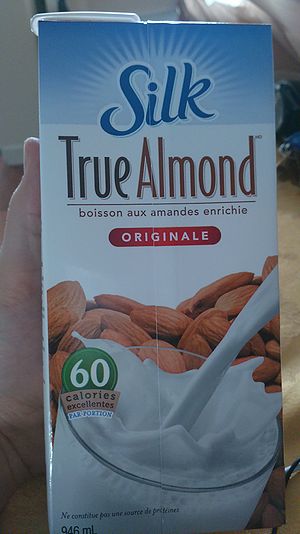 |
I chose this particular product because it is one of the milks that is consumed regularly in my household, the reason being is that my mother is lactose-intolerant and I feel like I am being to see the same symptoms as her when I drink whole milk. |
1) Does almond milk have the same nutritional value as milk that has lactose in it? 2) Is almond milk "healthier" for you? 3) What is the process in which almond milk is made? 4) What does "Locust Bean Gum" contribute to almond milk? 5) Why does this almond milk have a warning "May contain Coconut"? |
| Moore, Harriet | File://localhost/Users/julianberger/Desktop/1010751 10151454464247111 532576946 n.jpg | 1.My friend Amy contracted typhoid fever by the ingestion of a food, contaminated with the feces of an infected person
2. a) Who was affected? My friend Amy b) What was consumed? She believed the suspected contaminated food was a meat dish of some sort she had one afternoon on her travels 3. What were the symptoms? Some of her symptoms included: poor appetite, headaches, high fever (104 degrees), lethargy, diarrhea 4. When did it happen? Two years ago 5 Where did it happen? India 6. How did it resolve? She was able to seek medical care and treatment at the local hospital in Winnipeg, Manitoba |
What other questions do you have about this incident? How is typhoid spread? Where in the world do you get typhoid fever? How can you avoid it? |
| JonathonNaylor | 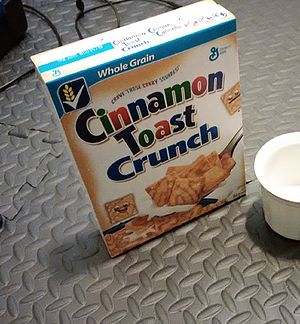 |
I chose this food because I had an overwhelming craving for this specific cereal and when I read the ingredients list it had some really interesting things listed. |
|
| (Insert Your WikiID) | thumb|(Insert Caption) | (Insert Answers) |
(Insert Responses) |
| (Insert Your WikiID) | thumb|(Insert Caption) | (Insert Answers) |
(Insert Responses) |
| (Insert Your WikiID) | thumb|(Insert Caption) | (Insert Answers) |
(Insert Responses) |
Family Names that Start with 'O'
| Your Wiki ID | Photo of the Food | Option A: What happened? Option B: Why Did You Select This Food? |
Questions You Have |
|---|---|---|---|
| (Insert Your WikiID) | thumb|(Insert Caption) | (Insert Answers) |
(Insert Responses) |
| (Insert Your WikiID) | thumb|(Insert Caption) | (Insert Answers) |
(Insert Responses) |
| (Insert Your WikiID) | thumb|(Insert Caption) | (Insert Answers) |
(Insert Responses) |
Family Names that Start with 'P'
| Your Wiki ID | Photo of the Food | Option A: What happened? Option B: Why Did You Select This Food? |
Questions You Have |
|---|---|---|---|
| Andreea Popa | 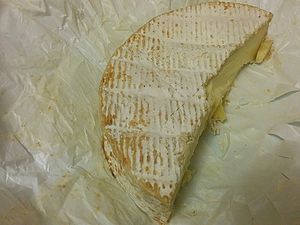 |
One of my best friends, Natasha, is lactose intolerant. During a girl's night at my house, we decided to make nachos with an assortment of ingredients including tomatoes, olives, guacomole, and cheese. We all love nachos so naturally Natasha was just as excited as us non-lactose intolerant girls. She was so excited, that she forgot she was eating cheese, and did not take her Lactaid pills thirty minutes prior to prevent the symptoms of intolerance after consuming the cheese.
Natash quickly realized that she had not taken her pills as she started to feel extreme stomach pains and cramps. She also felt very nauseous. Because she was uncomfortable, Natasha had to lay down on the couch to try to alleviate the pain along with ingesting her Lactaid pills. After a while she started to feel better and rejoined the fun. Natasha has since learned that she should never forget to take her pills before consuming any dairy products. |
1. When ingesting the lactaid pill, how pure is the lactase in the supplement? 2. How come some people have mild forms of it and some have extreme forms of the intolerance? 3. What kinds of modified foods cater to people with this intolerance? 4. What are the statistics of Canadians with lactose intolerance? 5. Can lactase be ingested through natural food sources? |
| (Insert Your WikiID) | thumb|(Insert Caption) | (Insert Answers) |
(Insert Responses) |
| (Insert Your WikiID) | thumb|(Insert Caption) | (Insert Answers) |
(Insert Responses) |
Family Names that Start with 'Q'
| Your Wiki ID | Photo of the Food | Option A: What happened? Option B: Why Did You Select This Food? |
Questions You Have |
|---|---|---|---|
| (Insert Your WikiID) | thumb|(Insert Caption) | (Insert Answers) |
(Insert Responses) |
| (Insert Your WikiID) | thumb|(Insert Caption) | (Insert Answers) |
(Insert Responses) |
| (Insert Your WikiID) | thumb|(Insert Caption) | (Insert Answers) |
(Insert Responses) |
Family Names that Start with 'R'
| Your Wiki ID | Photo of the Food | Option A: What happened? Option B: Why Did You Select This Food? |
Questions You Have |
|---|---|---|---|
| (RachellynRitchie) | 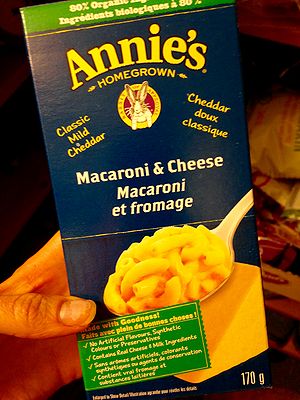 |
(I know mac and cheese gets a bad wrap, but I really like this kind and Im wondering if it's better since it's organic. I probably eat it once a week so it would be a good thing to know :)) |
(1)how is the milk and cheese in the powder prepared? 2)What part are they referring to as organic? 3)what is the shelf life of a box of this? 4) why does it taste better than regular mac and cheese? 5) would real cheese have been used and what is it called in this dehydrated form? ) ANSWERS 1) The milk would have to be dehydrated by in an evaporator as well as the cheese. Lesson 8 talks about dehydration methods, although evaporation is not one of the methods mentioned. 2) Organic refers to foods produced via organic farming methods (ie. no synthetic pesticides, hormones, irradiation etc. ) Organic here is most likely referring to the cheese from dairy cows that were not given hormones, and wheat that has been organically farmed. Government health departments such as health Canada would be responsible for setting the guidelines for use of the word "organic". 3)The shelf life would be classified as shelf stable (lasting longer than 6 months) since the water activity of the dehydrated milk and cheese is so low and pasta also has an extremely low water activity. shelf life is discussed in lesson 5 and pasta is categorized as a "shelf stable" food. 4) This can't necessarily be answered using class notes, however when I make it, I use lots of butter and butter adds to the mouth feel. Also, The cheese they use could contribute to the flavour if it is a stronger cheese. 5) Yes, real cheese would have been used and it is called powdered or dehydrated cheese. |
| (BrandonRay) | [[(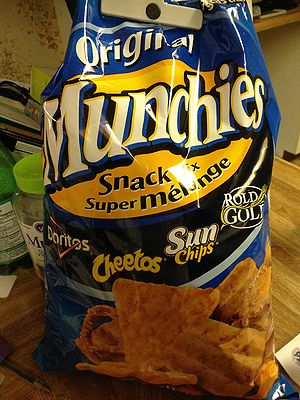 |
(It seems as though this chip mix has been a staple in my house since childhood, I'm just curious to learn a little bit more about it.) |
(1. Are all of the different snack foods included in this mix preserved by the same preservatives? 2. Are they all cooked/fried/baked etc. in the same way? 3. How many of the ingredients are "real" ingredients, and how many are made synthetically. 4. Would these snacks all go stale at the same rate? 5. Are the cheese flavoured snacks flavoured by the same artificial cheese? ) |
| (Insert Your WikiID) | thumb|(Insert Caption) | (Insert Answers) |
(Insert Responses) |
Family Names that Start with 'S'
| Your Wiki ID | Photo of the Food | Option A: What happened? Option B: Why Did You Select This Food? |
Questions You Have |
|---|---|---|---|
| (14577143) | 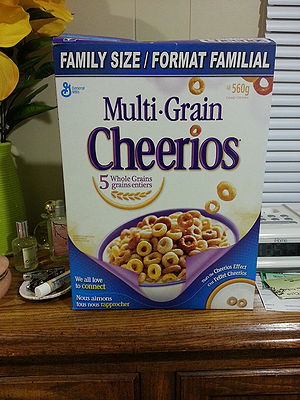 |
I chose Multigrain Cheerios because cereal is a staple in my diet. I don't usually have much time for breakfast in the mornings, and cereal is a quick way to start my day. I am interested in knowing more about this food since I consume it almost every day. I also think that everyone should know more about what they are consuming especially since cereal is a popular food item. Considering its simplicity, it is an interesting food nonetheless. |
1. What compounds preserve cereal? Sugar would be the main preservative, it usually coats the outside of flakes, or in this case the cheerios. 2. Why does it last so long? I would say that cereal has been dehydrated using a drum dryer, therefore getting rid of the water so that no spoilage causing microorganisms could grow. This is why it can last a long time without the need to be refrigerated. 3. How do they dehydrate the cheerios pieces? I think that they would dehydrate the food pieces using a drum dryer. 4. How come most cereals have s high sodium content? I think that they have higher sodium content than some foods because salt is also used as a preservative to prolong the cereal's life on the shelf. 5. Does cereal count as a GMO? If so, what exactly is modified and is it harmful?) Cheerios do not contain GMO's although many cereals do, mostly to prolong the shelf life. The most common cereal GMO is modified corn. |
| (tshum) | 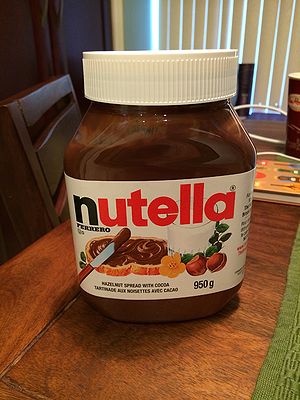 |
I chose a jar of Nutella because it is my favourite spread to use on anything! Pancakes, crepes, bread, ice cream, etc. I also just came back from exchange in France, and the French love to use Nutella, so I definitely ate a lot of it while there. Since I consume it quite a lot, I am interested in learning more about its properties, and how healthy and or unhealthy it is. |
1. Is it healthier than peanut butter? 2. What makes it so viscous? As opposed to peanut butter, which is more solid 3. What gives it its brown colour? 4. What preservatives are in it? 5. What is the best way to store it? In the fridge? In the pantry? Answers: 1. It depends on what you consider as "healthier." As we learned in lesson 4, it is important to consult labels of products to determine the ingredients and health benefits. Nutella has 11g of fat per serving, but Kraft's Smooth Peanut Butter has 1.7 g of fat per serving. So it really depends on if you define healthier as less fat. Therefore, using this measure, peanut butter is healthier. As I learned while doing my final project, it is also important to not be fooled by labels that have "low-fat" or "reduced-fat" on it- as labels can be deceiving and could have more of another bad substance to compensate. 2. I do not think we covered this particular question in the course, but I am guessing that it is vegetable oil that makes it very viscous. In nutella, the vegetable oil is 2nd on the list, while on peanut butter it is 5th, meaning that there is a lot more vegetable oil in nutella than peanut butter. I also see on the label that there is an emulsifier in Nutella, which we learned in Lesson 2 it keeps the mixture stable and to prevent it from separating. 3. Its brown colour pigment comes from the cocoa powder, which I consulted on the label. 4. In looking at the label, there does not appear to be artificial preservatives in Nutella. However, like jams, there is a lot of sugar in nutella, which we learned in class can act as a preservative. Sugar is also the first ingredient listed, so we know that it is quite abundant in Nutella. 5. Best way to store Nutella is in the pantry. As we learned in lesson 5, storing food in the refrigerator helps slow down microorganism growth, but does not destroy it completely. However, Nutella does not need refrigeration because it is a shelf-stable food. |
| (aka27) | [[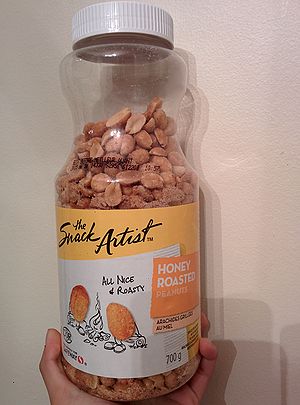 |
I chose honey roasted peanuts by The Snack Artist because they are a part of my daily diet and I consume them like snacks with fruits or yoghurt. I enjoy the natural crunchiness of peanuts infused with the honey flavour. Another reason why I chose this product was that I have always eaten peanuts in their natural form in India and it was only in Canada that I saw a variety of flavours and I have some questions about the processing and additives used while making such different flavours. |
1. How is it processed? A: We haven't specifically talked about the processing techniques used for peanuts but as I was reading an online article about peanut processing on http://www.madehow.com/Volume-1/Peanut-Butter.html I could understand most of the technical terms due to my experience and learning in FNH 200. 2. What are the preservatives added since I could not see any chemicals in the list of ingredients and it stays good for about 11 months according to the expiry date. A: The team project by group 13 was about peanut butter and I learnt that sodium benzoate and Butylated hydroxyanisole are the two preservatives used. They prevent the growth of mould and spoilage. (Taken from: UBC wiki, FNH 200, Team Projects 2015 Group 13). 3. How does it compare to naturally found and consumed peanuts, nutritionally? A: We did not talk about this directly, however from my understanding of processed foods (FNH 200 lesson 11), I can conclude that commercially packaged peanuts are safe to consume and nutritionally healthy as long as the manufacturers use only the FDA-approved preservatives & additives. 4. How do they process the peanuts to prevent over-hydration and/or other environmentally-triggered spoiling of food? A: Freezing is an appropriate method to preserve peanuts for long periods of time. When stored, they should be in tightly sealed containers. They can be salted, roasted or converted into peanut butter. (FNH 200 notes)
|
| (RebeccaStephens) | 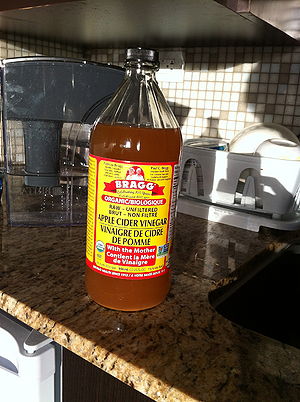 |
I chose apple cider vinegar because it is something I always keep in my cupboard. I usually use it to make salad dressings or dilute it with water to consume as a drink. I started doing this because I heard it had many health benefits. Apparently it improves digestion. I’ve always been curious if this is related to the fermentation process undertaken in the processing of apple cider vinegar. |
1.) How does apple juice change chemically during the fermentation process to create apple cider vinegar? As mentioned is Lesson 1, apple juice is the starting material for apple cider. After apple cider is produced it can then be converted into apple vinegar. Before making apple vinegar, apple juice is combined with certain yeasts. These yeasts act to promote fermentation of the sugars in apple juice. This changes the sugar into ethanol. The ethanol that is created through the addition of yeast to apple juice creates the tart flavor of apple cider. With the creation of apple cider, one can take one more step to create apple vinegar. Apple vinegar is made by adding bacteria culture to apple cider. This makes apple vinegar by “oxidizing” the ethanol in the apple cider into acetic acid. 2.) What steps are necessary to take during the fermentation process of apple cider vinegar to ensure it is safe to consume? As Lesson 9 describes, to promote food preservation by fermentation one must encourage the “growth and metabolism of alcohol and acid-producing microorganisms.” This acts to simultaneously suppress the “growth and metabolic activities of proteolytic and lipolytic, spoilage-causing microorganisms.” This state is called “microbial antagonism” and it is a necessary condition to safely preserve food during fermentation. 3.) What makes the bacteria present in apple cider vinegar beneficial to people while other bacteria can be harmful? Lesson 9 illustrates that the fermentation version of a food can be more nutritious than it’s unfermented form. When mould is produced in the fermentation process sometimes this mould can “synthesize B-vitamins.” The microorganisms present in fermented foods can make nutrients more available for human digestion. This is because some parts of plants are not digestible for humans. So fermentation potentially enhances the access that humans have to these vitamins and minerals that would usually be undigestible in the foods unfermented state. 4.) I noticed a gel layer forms at the surface of my vinegar when it is not used for a long period of time. What causes this? This is not discussed in our Lessons but it could be a build up of the bacterial culture that is added to apple cider to produce apple cider vinegar. From my research the gel is a build up of cellulose and acetic acid bacteria. This build up can be used to change alcohol into acetic acid when oxygen is added. Perhaps when the vinegar is left sitting this causes the bacteria culture to grow together in a clump like structure. Maybe the bacteria rises to the top of the bottle because that is where oxygen is most accessible. The bacteria growing in apple vinegar is aerobic. 5.)Is the bacteria present in apple cider vinegar beneficial to the human gut micro biome as many “health experts” like to claim? As mentioned in Lesson 9 the bacteria implicated in the fermentation process is beneficial to the human gut because it makes certain nutrient that were once inaccessible, accessible to humans. These microorganisms help break down some of the fiber which previously locked nutrients in the plant tissue and made certain nutrients indigestible for the human digestive tracks. This is how fermentation has the effect of enhancing nutritional value of foods. As Lesson 9 mentions, this occurs by “microbial hydrolysis of cellulosic material which are indigestible.” So this makes fermented foods more digestible. |
| (JoachimSpeidel) | 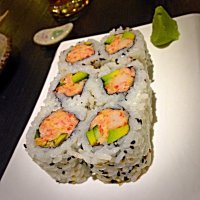 |
Sushi forms a large part of my diet during school because it is fast to make, and you can buy it for cheap. As a student, food with a high energy value that can be prepared fast such as sushi are very ideal. I like to consume sushi because it has high levels of carbohydrates and protein and the portions are bite size. |
1. Does sushi contain enough fiber in proportion to the carbohydrate and protein ratio? An article on Harvard Health by Patrick J. Skerrett (2013) states that an ideal carb to fibre ratio is of '10 to 1' and california rolls contain about 20g to 3 of fibre. The ratio in california rolls is decently close to the article's ideal standard. 2. What is in the "crab meat"? Team 13's project identifies imitation crab as ground fish paste, which is"mixed with binding and flavoring additives, shaped, and dyed red on the outside to mimic the taste and appearance of real crab meat" 3. Does sushi contain too many carbs in proportion to all the other macronutrients? I would say yes, it contains about 1/7 protein to carb ratio. 4. Is it actually healthy? If made using food without harmful chemicals, then yes. 5. How healthy is it regarding sodium and other micronutrient content? One piece of california roll contains 11%DV of sodium, so it is in the high end of sodium. If you consume 6 rolls or so, then it is not too much References: http://www.health.harvard.edu/blog/the-trick-to-recognizing-a-good-whole-grain-use-carb-to-fiber-ratio-of-10-to-1-201301145794 http://wiki.ubc.ca/Course:FNH200/2014w_Team13_ImitationCrab http://www.calorieking.com/foods/calories-in-japanese-california-sushi-rolls_f-ZmlkPTExNTEyNQ.html |
Family Names that Start with 'T'
| Your Wiki ID | Photo of the Food | Option A: What happened? Option B: Why Did You Select This Food? |
Questions You Have |
|---|---|---|---|
| (ktodter) | 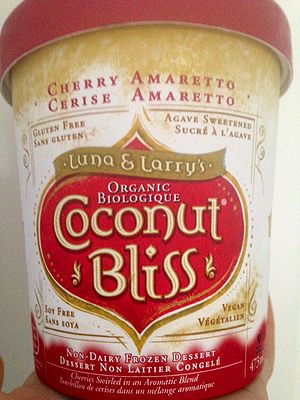 |
I chose this dairy-free alternative desert because I LOVE coconut, plus I almost always have this in my freezer. I try to stay away from milk products in general because of the hormones and Coconut Bliss is almost all organic and no added sugar, so if you are looking for a good treat give it a try! (Plain coconut is the best flavour) |
1. How is agave turned into syrup? (lesson 2 & 3) Step 1. Agave leaves are crushed or pressed by hand or in a mill to extract the pina at the core (the juice) Step 2. Juice is filtered to create nectar (solids are removed through fine filtration process) Step 3. Nectar is heated at different levels of heat (less than 118 degrees) for a longer time > causes thermal hydrolysis which breaks down carbohydrates into sugar= inulin or fructosan into glucose 20% and fructose 75% Step 4. Filtered juice now becomes concentrated into a syrupy liquid (still thinner than honey and 1.5 times sweeter than sugar)
2. Is agave syrup highly processed? Natural/ Organic agave syrup is made without chemicals and is heated at less than 118 degrees—this is a process that can even be done at home. Therefore organic agave is a moderately processed food. (lesson 2) Commercial agave is generally highly processed. During the heating process caustic acids, clarifiers and filtration chemicals are used, resulting in syrup that is 70% – 92% pure fructose. This is actually higher than high fructose corn syrup! (lesson 3) 3. How does guar gum + water + coconut become creamy and icy? -The mixture of organic coconut milk organic coconut, water, organic guar gum, organic agave syrup, organic cherries, organic coconut cream, organic almond extract, and organic vanilla extract is churned in an ice cream maker while being kept below freezing temperature of water to prevent crystals. The ice cream paddle churns and whips air into the mixture giving it a creamy texture. (lesson 2) -Guar gum is a plant exudate from the bark of the acacia trees used as thickener and stabilizer in ice cream. (lesson 2) -Guar gum is a polysaccharide stabilizer compound that increases the viscosity of the continuous phase (water), keeping the droplets suspended or dispersed and thus reducing the rate of creaming. (lesson 2) -Ice cream is a solid foam. This means the proteins have the ability to trap air in bubbles and this leads to the formation of foams. Whipping introduces air and denatures (unfolds) the protein molecules. The protein molecules then coagulate to form a fine film around the air pockets. Solid foams (ice cream) is formed when the whipped product is heated causing the protein to denature and form a more rigid three-dimensional structure, which won't collapse when the air escapes. (lesson 2) -Shrinkage and development of graininess in frost-free freezer section in the refrigerator is due to partial melting of the ice cream during temperature fluctuations that result from the defrost cycles. This leads to foam destabilization and crystallization of lactose as a consequence of concentration effects. (lesson 7) 4. How is almond extract "extracted"? This can be done with a special machine designed for pressing foods like almonds. As they pass through the liquid component is squeezed out. When done commercially this process usually uses a cyanide precursor. (milling & grinding lesson 11) To make homemade almond extract one should use 12 raw skinless almonds (chopped) with one pint 80 proof vodka (40% alcohol weight for every desired pint of extract). Add the two together and let sit for 2-3 months in a dark place. Shake the bottle once a day. When finished aging strain the liquid with a cheesecloth and store in a dry dark place. This is a process of fermentation. 5. How long can you leave ice-cream in the freezer before it becomes soup-y? Ice cream is a semi-perishable Food. Semi-perishable foods last between 2 to 6 months as a result of some form of preservation method. Examples of semi-perishable foods are: ice cream, cheeses, and dry snack foods. (lesson 5) References: http://www.globalgoods.com/manufacturingagavenectar.html http://commonsensehome.com/how-to-make-homemade-extracts/ http://realfoodforager.com/why-i-never-use-agave/ http://wholesomesweeteners.com/Agave-Fact-vs-Fiction http://wiki.ubc.ca/Course:FNH200/Lesson_05#Semi-perishable_Foods http://coconutbliss.com/info/all-products-ingredients |
| (marbean) | 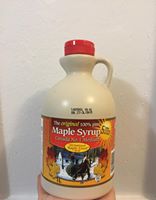 |
I chose 100% Maple Syrup because I use it frequently and enjoy it very much, and it also makes me feel very Canadian. I love having it on my oatmeal, pancakes, and french toast, so I don't seem to care that it is high in sugar and not very healthy. This definitely does not stop me from eating it. |
1. Why is pure maple syrup naturally so high in sugar? 2. How does it get such a thick, smooth texture? 3. Would it be possible to get syrup from maple trees in Western Canada? 4. How is maple syrup produced in large scale? 5. Is the processing of maple syrup different than other types of syrup? |
| BettyTse | 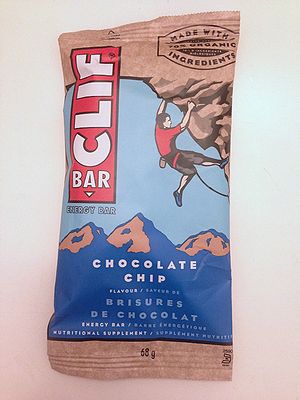 |
Having a busy schedule means that a lot of the times I am in a rush or have very little time to prepare a proper meal. Whenever I leave the house, I grab a Cliff Bar because it's already prepared and great for on the go. They are made with 70% organic ingredients and are an easy source of energy for the day. Cliff Bars also come in a wide range of different flavours. |
|
| Takhar, Annisha | 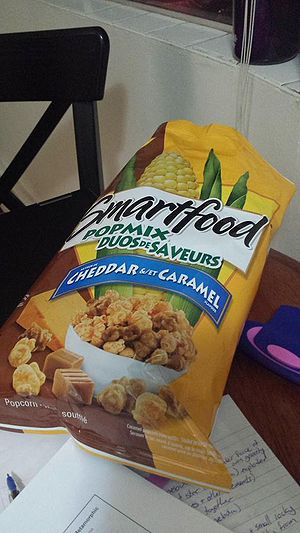 |
I picked this food because it is one of my guilty food pleasures. I love the combination of sweet and salty flavors together. I always buy this if I'm going to have a junk food movie night with my friends or family. |
1. How are the cheddar and caramel flavors processed into the popcorn?After looking at a few YouTube videos about “Chicago Mix” popcorn (which is what this type of popcorn is called), it looks as though after the popcorn is air popped it is put into a big mixing vat that is constantly rotating and mixing the popcorn. Then a steady stream of flavouring (liquid cheese and/or Caramel) is poured over the popcorn while it is constantly being mixed. Then the metal vat continues to mix until the flavouring is dried out into the popcorn. 2. Is the corn that's used a GMO?There is nothing on Smartfood’s website or anywhere else that I have researched to indicate that they do not use GMO corn in their popcorn products. Lesson 9 states that a Genetically Modified Organisms ("GMOs") are plants, animals and microorganisms in which there is a change to the DNA of the organism by intentional manipulation. Although there is no proven evidence that GMOs are harmful in any way, people tend to stay away from ingredients that contain GMOs. 3. Why do they market this as "smart food" when it's clearly junk food?I think the brand “Smartfood” is simply just a branding tool used in the marketing of their products. Technically this processed food is junk food; however, when researching on Smartfood’s website (www.smartfood.com), they seem to pride themselves in not using preservatives or artificial colorings, using only 100% of the whole grain of the corn kernel, and air popping their kernels. All of which they claim is “smart and simple” and “better for you”. 4. How much processing is required to produce perfect kernels of popcorn?I don’t think much processing is needed to produce the perfect kernels of popcorn. It seems as though the kernels are air popped, and sifted and selected by size in order to ensure consistency in production, which is what contributes to the perfect kernels of popcorn in each bag. 5. Why is there only a "freshness" date but not an expiry date?The date on the package is the freshness date and corresponds to the snack remaining fresh if stored in the original packaging until the date on the bag. There is no expiry date because, as stated in Lesson 4, foods with a storage life of 90 days or less only require an expiration date. Popcorn has a much longer shelf-life and when kept in the original packaging, will not spoil. |
Family Names that Start with 'U'
| Your Wiki ID | Photo of the Food | Option A: What happened? Option B: Why Did You Select This Food? |
Questions You Have |
|---|---|---|---|
| (Insert Your WikiID) | thumb|(Insert Caption) | (Insert Answers) |
(Insert Responses) |
| (Insert Your WikiID) | thumb|(Insert Caption) | (Insert Answers) |
(Insert Responses) |
| (Insert Your WikiID) | thumb|(Insert Caption) | (Insert Answers) |
(Insert Responses) |
Family Names that Start with 'V'
NancyVu
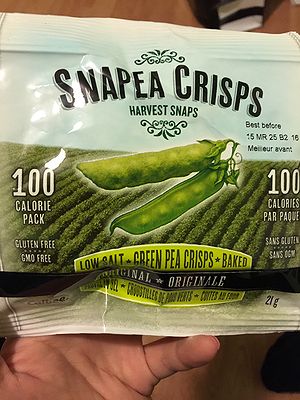 |
B:100 calories a pack, made from 70% whole pea, baked, low salt content, gluten free and gmo free. An awesome alternative for chips. | 1. What requirements must a product meet to be gmo free? 2. what main ingredients in these crisp would be mainly responsible for its' puffy texture(green peas, vegetable oil(canola, sunflower, and/or saffkower oil), rice, salt, calcium carbonate, ascorbyl palmtate)? | |
| KarlyVanichuk | 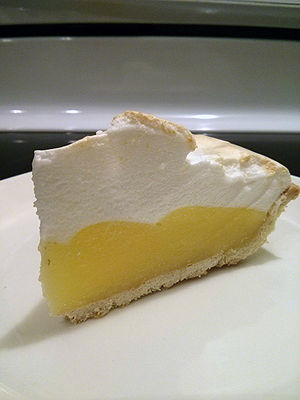 |
I chose lemon meringue pie because I love to bake and it is an example of things we've covered so far in the course: fat and gluten in the crust, a solid foam (meringue), and the tart flavour from the acidic lemons. Also, I love pie. |
1. Why is cream of tartar added to the egg whites? 2. Usually the meringue sticks to the fruit layer but sometimes the bottom is watery and the meringue slides off. What causes this? 3. How does using different types of fat in the crust affect the texture? 4. Can I make a pie with sweeter citrus fruit, such as oranges? 5. Would a meringue work if made with an artificial sweetener instead of sugar? |
| (Insert Your WikiID) | thumb|(Insert Caption) | (Insert Answers) |
(Insert Responses) |
Family Names that Start with 'W'
| alexiswo |
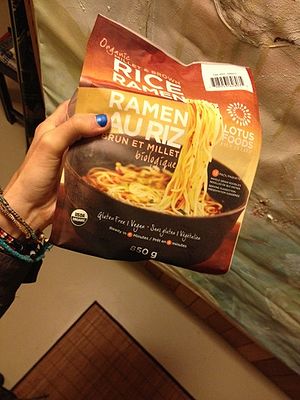 |
! Option B: I chose this rice ramen because I was both excited and curious about the ingredients of this product. I chose to buy these ramen noodles because they were vegan and gluten free and organic. I try to eat the simplest, high carbohydrate foods available and these are instant and high in carbohydrates, low in sodium and low in fat. |
! Questions: 1. What is the thickening agent to contribute to these noodles having a similar consistency to egg-based noodles or typical gluten noodles?
2. How is the rice and millet processed to create the noodle texture? 3. What contributes to the ‘instant’ element of these noodles? How can they be ready to eat just by pouring hot water over them with minimal cooking time? 4. How does the organic certification factor in to the mycobacterial and biological makeup of the product? Are the materials (rice, millet, whole grain) all organic and does these mean they have the same chemicals and bacteria as other non-organic materials? 5. Why do the noodles appear wavy and does the rectangular shape of each individual serving (wavy noodles condensed into small 3 x 4 inch rectangles) have a role in the expedited heating process of this food? 1. I searched through lesson 2 regarding the thickening agent used for millet rice noodles, but the lesson did not cover gluten free noodles so I researched what may have been used and it appears that sodium polyacrylate could be a potential thickening agent to improve textural stability for wheat free noodles. Found at: GB/T 2760. 2010. Code of National Standard of China. 2. Rice millet noodles are noodles that are made from rice and millet. Their principal ingredients are rice flour and water. However, sometimes other ingredients such as tapioca or corn starch are also added in order to increase the gelatinous and chewy texture of the noodles. (Lesson 4 and 3.) 3. Considering what we learnt in lesson 8 regarding food dehydration methods, these noodles could be instant because they may have been deep fat fried to remove water. This would remove all the water and replace it with oil and once the water activity has been lowered, it cannot support microorganism growth. The holes and gaps in the noodles are now filled with oil but when we add water to them, they go back to their original shape! 4. In regards to the nature of the “organic label”, it is hard to know the exact microbiological makeup of conventional vs. organic foods. We did not cover the particular attributes that qualify a food as “organic”, however, I may look into this more on this website: http://www.theorganicprepper.ca/the-dirt-on-rice-literally-12162012 5. We did not discuss why the shape of instant noodles appears wavy in a rectangular shape in FNH 200, but I will assume it is related to the rehydration process for the instant noodles. The wavy shape may contribute the a faster water re-absorption process. If I refer to lesson 3 on the sensory properties of foods, it could be possible that the wavy shape contributes to both the appearance and textural factors of the food, which may even influence the flavour and overall mouthfeel of the noodles. Another presumption could be that the wavy shape of the noodle allows a smaller package, with longer noodles to be produced for the consumer, saving packaging and storage space. |
|---|---|---|---|
| DavidWong (dwong625) | 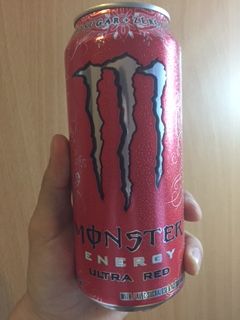 |
I choose this product because it's something I drink on a regular basis. It's good to have an idea of what's in the things you consume regularly. | 1. What do they mean by zero sugar?
2. What really makes it red? Does it have something to do with the flavour? 3. Do these ever expire? 4. How do energy drinks compare to coffee? Is one better than the other? 5. What's wrong with consuming more than one can (473mL) a day? Answers 1. Zero sugar means no added sugar (Canadian Food Inspection Agency) 2. According to the company, it is just red food coloring. And coloring is added for consumer appeal (http://wiki.ubc.ca/File:Coloring_for_Consumer_Appeal.pdf) 3. Canned products have a shelf life of at least 2 years (Lesson 6) 4. I suspect that energy drinks are much stronger than regular coffee as the purpose of energy drink is the give people the boost of energy they need. Thus there must be added ingredients to boost the caffeine concentration (Lesson 4) 5. I suspect that consuming more than 473mL a day will lead to health risk as a result of overconsumption (Lesson 12) |
| NathanWong | 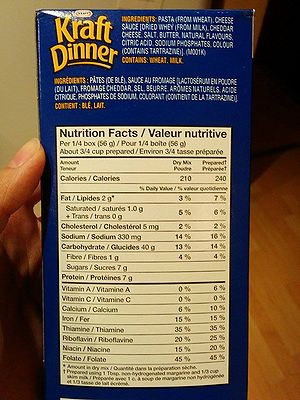 |
Kraft Dinner is a well-known processed food product that is quite popular. Although I consume it infrequently, I have many friends who love the taste of the cheesy pasta affectionately known as "KD". I am interested in learning more about the food science and the production of KD. |
1. What is the coloring, tartrazine? Tartrazine, also known as Yellow 5, is a lemon-yellow dye used in food coloring. The reason it is most likely added to Kraft Dinner is because the cheese sauce, which comes in a powder, is processed in such a way that the final product may not appear yellow, which is the color consumers associate with cheese. As we learned in Lesson 03, sensory perception of food is the reason why consumers choose a particular product - if the "cheese" does not look appealing (appearance being the first factor consumers consider when selecting a food product), and thus falling outside of out preset limits of acceptable quality, we will reject it. The tartrazine is therefore used to create a pleasant color. 2. What happens to the product years after its expiry date? Without consideration of the taste, would the product be safe to consume? As this product has an expiry date of almost 2 years or more, it is classified as a shelf-stable (greater than 6 months) food (Lesson 05). The product contains a wheat product, the pasta, and a dried cheese powder, both of which are shelf-stable at room temperature. In the ingredients list, the powder contains 'enzymes', which can break down or denature over time, adversely affecting the quality of the cheese product. If stored properly, and if the packaging is intact, I would assume that the product would still be safe to consume past its expiry date, as it would be difficult for it to spoil. However, if the packaging is damage, this would expose the product to air, causing oxidative degradation and possible microbial contamination, making it unsafe to consume. 3. How is the pasta shaped and dried in the manufacturing process? The flour is likely combined with water to make a mold-able mass of viscous "paste" in a large production machine. It would then be forced through a shaping machine and chopped with a mechanical blade every centimeter or however long each pasta segment is. The pasta uses dehydration as a preservation method. As learned in Lesson 08, there are many methods for drying products such as macaroni pasta. However, as this pasta is mass-produced inexpensively, the most likely method of preservation is drying through extrusion, during the shaping process, as the slurry of flour paste is passed under pressure heated by steam. The moisture and heat would cause the starch to gelatinize, cooking the product. 4. Where does the folate, thiamine, and riboflavin come from? These nutrients come from the enriched flour used to make the pasta. Enriched flour is flour with certain nutrients re-introduced that were lost in the processing step when it was being refined. This allows the processed flour to have a similar nutritional profile to the unrefined product. However, enriched flour is lower in fiber than whole flour, which makes it less beneficial to consumers. 5. Why does the "cheese" look like a powder? The cheese is a powder because it a mixture of a few different ingredients that has been dehydrated through the process of spray drying (Lesson 08). Spray driers produce large quantities of commercially dehydrated foods. The cheese sauce is a liquid once reconstituted, and is likely a liquid before it is packaged. Spray driers take this liquid and produce particles of uniform size, by introducing the food as a spray of small droplets into a stream of hot air. Thus, the rates of drying are very quick due to the small particle size. |
| YuanWang | 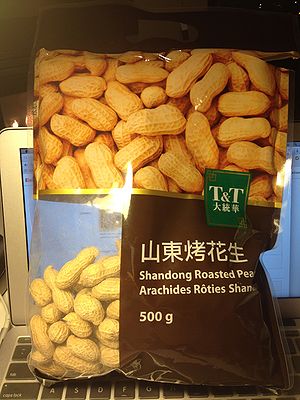 |
I select this food because it is a popular snack, my roommate has a large stash of this in our apartment. It is high in calories, sodium and fat. I want to know more about it and try to convince my roommate to give it up. |
1. How does it processors choose the best peanuts? 2. What is the nutritional difference between this and fresh peanuts? 3. On the package it says "Peanuts, also known as Fruit of Longevity". How do people live longer by eating that? For my first question, I think the first thing is to look at outlooks of the peanuts. A “good” peanut should at least have no bruise and shrink (dehydration) in it outlook, also no moulds and any other traces of activities resulting from spoilage-cause microorganism should appear. Since peanut is high in fat, no peanut with oxidative rancidity should be sent to further processed. In terms of the second question, according to Lesson 11, certain degrees of loss of nutrients are inevitable. For example, the nutrient loss of peanuts could occur during storage due to environmental factors such as oxygen, moisture and temperature. As well as this, since the higher the temperature in processing, the more nutrient destruction occurs. Therefore, the roasting process may do well in retention of aesthetic attributes but badly in retention of nutrient. For the third question, I searched the Google scholar but I found no journal article relate peanuts with life extension. Instead, I saw great number similar claims appear in advertisements. Thus, I tend to conclude that it is just for luring consumers. |
| EricWhitehead | 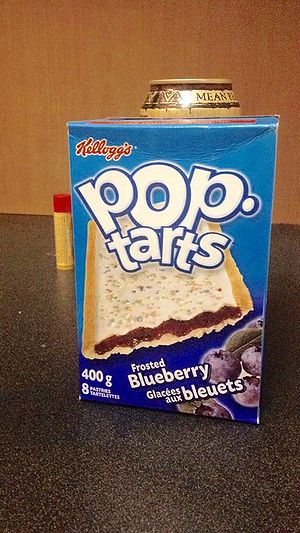 |
I eat Poptarts on early mornings to get a quick wave of carbohydrates and sugar to wake myself up for class. They are not the healthiest option ever but they work as an anytime snack on the go. I want to know more about it to possibly convince myself for sure that I shouldn't eat these in the morning. |
1. How is the inner filling preserved? |
| MengxiWang | 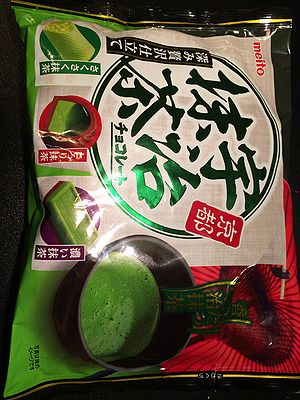 |
Option B. Matcha is my FAVOURITE flavour. This chocolate melts as soon as you put it in your mouth. Yum yum. It's a perfect snack for school, watching movies, reading, studying, walking, jumping, swimming everything lol. |
1. What kind of sugar is added in this Chocolate?
2. Can I make this chocolate at home?
3. As an imported product oversea, I wonder whether its taste change during the long transportation?
4. Any allergen component?
5. Whether there is any colouring chemical composition?
|
| Kaayla Whachell | 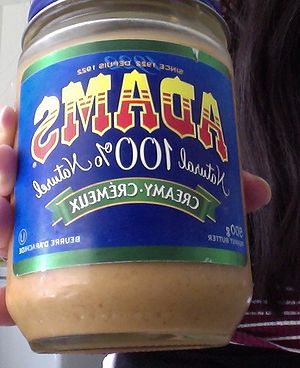 |
Option B I like Adams Peanut butter because it only has two ingredients, peanuts and salt. I have a allergy to corn starch and its hard to find a peanut butter that doesn’t contain corn starch. |
1. Where do they get the peanuts from? The peanuts come from the U.S.A 2. How are the peanuts processed? 3. Is the peanuts organic or GMO 4. How long does the peanut butter last in the glass? 5. How many peanuts are put in one container of peanut butter?
|
Family Names that Start with 'X'
| Your Wiki ID | Photo of the Food | Option A: What happened? Option B: Why Did You Select This Food? |
Questions You Have |
|---|---|---|---|
| (Insert Your WikiID) | thumb|(Insert Caption) | (Insert Answers) |
(Insert Responses) |
| (Insert Your WikiID) | thumb|(Insert Caption) | (Insert Answers) |
(Insert Responses) |
| (Insert Your WikiID) | thumb|(Insert Caption) | (Insert Answers) |
(Insert Responses) |
Family Names that Start with 'Y'
| Your Wiki ID | Photo of the Food | Option A: What happened? Option B: Why Did You Select This Food? |
Questions You Have |
|---|---|---|---|
| WingTungYu | 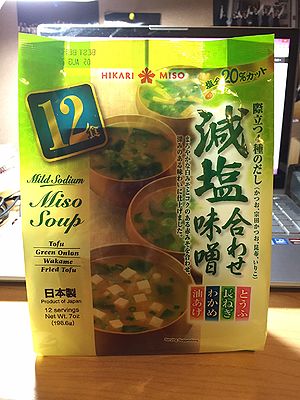 |
I have chosen instant miso soup because I find it really convenient and amazing that you can make miso soup with just miso paste and hot water. It originally requires more time and procedures so not many people are willing to spend the time to cook it. |
1. How did the miso soup paste becomes soup instantly ? When you add hot water to the paste, the paste could bind in and dissolve in the hot water which turns into the miso soup. 2. What are the procedures involved in making the instant miso soup? From chp 10, the paste (miso) is fermented from soybeans by moulds. There are also some dehydrated ingredients inside which its production method will be discussed in the next question. After processing, these ingredients are individually packed in individual foil packages (chp 6). The ones with dehydrated ingredients would be air-tight packaged so that no water can enter the package and the ingredients won't be crushed by external forces.(chp 8) 3. How can the producer dehydrate the tofu and kelp in order to include in the package? Most likely, the tofu and kelp will be dehydrated by freeze drying because after rehydration, they return and retain to their original form. (Chp 8) After you put hot water to it, the hard and dried tofu gets soft and the shape resumes. 4. How is miso prepared and produced originally? Miso is prepared by fermentation. Moulds fermented the soybeans to miso and help release the level of vitamin B in soybeans(Chp 9). Miso thus has higher levels of vitamin B. 5. How can the miso soup be preserved and kept for a long time? Miso is not an acid food but after fermentation, it promotes the production of alcohol/acid- producing microorganisms and inhibit the growth and metabolic activities of spoilage-causing microorganisms.(chp 9) These prevent the miso from turning bad easily. However, since miso is not an acid food, they are still placed in the fridge to extend their lifetime. In the instant miso soup, most likely the miso has been heat processed and placed in a pouch, so most spoilage and pathogenic bacteria has been destroyed(chp 6), so it does not require refrigeration and can still keep for a long time. |
| pauliney | 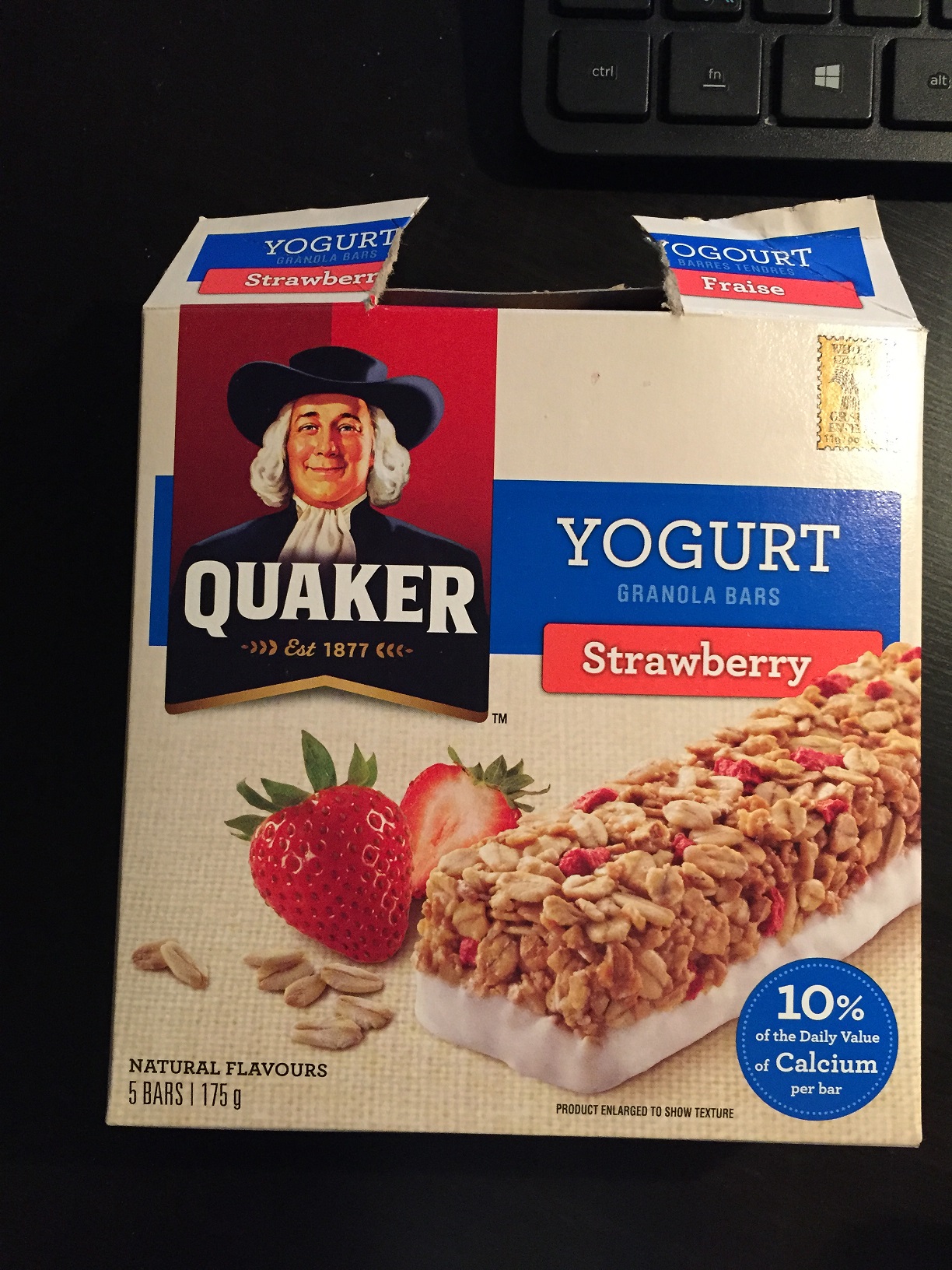
|
I chose granola bars because since I started university, I have been consuming a lot of them. You can find me eating them throughout the day (especially during exam season and in early mornings). I particularly love the ones with a yogurt covering, which is beneficial for me (in terms of my daily intake of calcium) as I do not drink milk or any milk alternatives. |
1. Why is the shelf life of these bars so long (even though it contains yogurt)? 2. What preservatives are added to this product? 3. Are any artificial flavoring or colours added? 4. Do these bars contain real fruit and real yogurt? 5. Are granola bars considered healthy or is that merely public perception? 1. I’m guessing that the shelf life of this yogurt product is long because it has been thermally processed by pasteurization (Lesson 06) or because it is made from yogurt powder which undergoes spray drying and the high temperatures may inactive or kill any bacteria that may contribute to spoilage (Lesson 08). Also, the yogurt coating is mostly composed of sugar and modified oils (palm kernel and palm oil) and not real yogurt which may explain the long shelf life. 2. Some additives added to this product include sodium bicarbonate (aerating agent), mixed tocopherols (class IV preservative), sodium alginate and lecithin (emulsifier/stabilizer/thickener), BHT (preservative), and sorbitol (sweetener) (Lesson 04). 3. From looking at the ingredients list, there are no artificial flavours or colours added. 4. From looking at ingredients list, the yogurt coating does contain yogurt powder (yogurt that has undergone spray drying – Lesson 08) however it is not the main ingredient and is made mostly from sugar and oil. The strawberry pieces in the granola bar are made from freeze-dried strawberries (Lesson 07) and also contains lots of added sugar. 5. We did not talk about nutrition/health aspects of certain food products in this course however from looking at the ingredients list, this product contains a lot of additives and sugar (and subsitutes) which I can’t imagine can be as healthy as I previously thought. The concept of 'healthy' is different for every person. I found an article by The Globe and Mail titled “Granola bars: A healthy snack or dressed-up junk food” that goes into detail about the ingredients and nutrition facts about granola bars that I will read when I have time. |
| (Insert Your WikiID) | thumb|(Insert Caption) | (Insert Answers) |
(Insert Responses) |
Family Names that Start with 'Z'
| Your Wiki ID | Photo of the Food | Option A: What happened? Option B: Why Did You Select This Food? |
Questions You Have |
|---|---|---|---|
| (BaoYing Zhang) | 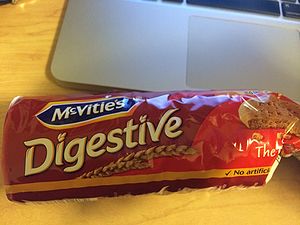 |
I took a picture of this Digestive biscuit because this was the only food in my dorm room. I thought it could be a good snack that wouldn't grow fat easily and convenient to eat when hungry. |
1.How much water content is in one biscuit? 2. How big will it become when it gets in contact with water? 3. Why is it call Digestive Biscuit? Does it really helps one digestive better? 4. Many people eats it as a meal for diet, does this way of diet really works and as good as eating bread? 5. On the cover, it says a good source of iron. Was the iron added into the biscuit as an additional mineral or does the whole wheat itself contains iron? |
| (ZhengZhao) | 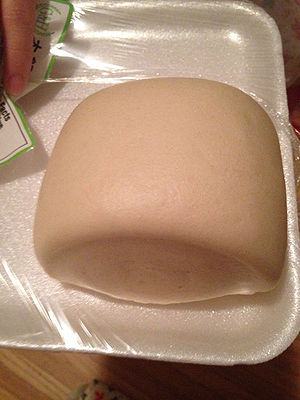 |
I love steamed bread for its taste and nutrition.It is convenient to eat and can be stored for quite a long time.Besides,people can digest it easily.It's beneficial to our stomach health. |
1.Why is it soft and elastic? 2.What makes it tastes sweet? 3.How is it stomatal inside? 4.What chemical reactions involed in its processing? 5.What is the nutrition value of steamed bread? For question #1, I think the soft texture of steamed bread is mainly because of the high moisture content. As we learned from lesson 02, the starch granule in wheat flour is not soluble in cold water but will imbibe large quantities of water when it is heated in water. And water hydrates flour protein to form gluten which is responsible for the elastic and springy structure in steamed bread (Lesson 02). 2. In some regions, people will add sugar to their steamed bread. In this case, sugar serves as a fermentable carbohydrates, also provides a sweet taste. However, as steamed bread contains starch, when we consume it, an enzyme in the saliva called amylase begins to break down the starches into glucose which can impart a sensation of sweetness(Lesson 02). 3.According to lesson 09, yeast reacts with glucose and other fermentable carbohydrates to produce CO2, alcohol and flavour. I think those CO2 is responsible for the interior stomatal texture. I will go to this website for more information. http://www.slideshare.net/CRISTI_P/chinese-steamed-bread 4.When the dough is steamed, the starch in the presence of water undergoes gelatinization with the loss of the crystalline structure and becomes amorphous. When the steamed bread is cooled, the amorphous starch chains interact with water and each other to undergo retrogradation, resulting in the structural firming. Also, fermentation is involved in the formation of soft dough. 5. The nutritional properties of steamed bread such as digestibility and glycemic index profile were little reported, but there is one fact for sure that steamed bread involves no maillard reaction; therfore, it will not lose soluble amino acids(mainly lysine) as baked bread will.
|
| (ShanShanZhao) | 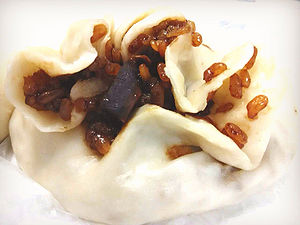 |
1. I was affected. 2. It was homemade shumai in small size, contained sticky rice and pork. I was not allergic to any of them. I believe I ate almost 30 pieces. 3. The symptoms was very similar to a fever. I felt cold, dizzy, and extremely nauseous in the midnight, with some abdominal pain. 4. It happened when I was at age 9 or 10. 5. It happened in China, at home. 6. I was sent to hospital the other day, spent three days at hospital, and was put on a drip. ) |
My questions: None of my other family members had the same symptoms, so I believe I was eating too much. I don’t understand why would eating too much cause me sick. I also don’t understand why I didn’t feel sick until midnight while I was eating in lunch time. Possible answer: After this semester, and especially according to Lesson 12, I think my case was a medical case and just because I am eating too much...as the instructor said in class, overeating anything can cause sickness. [ However, if it happened on all my families who eat the shumai that day, I think it could be identified as a food toxicant. In that case, I think the environmental toxicant of the meat in the shumai would be the most possible one, since the rice has less chance to be affected during the process. Since I had nausea, fever, vomiting after eating the shumai, it could be salmonella spp.]
|
| (zivn) | 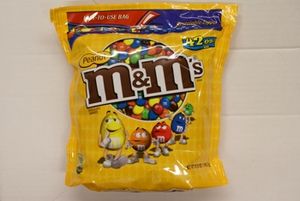 |
1) My Family and I travelled to Las Vegas 5 years ago. I visited the M&M factory there and purchased a big pack of M&M Chocolate Peanuts. Later that day, my father ate a few pieces and got a severe allergic reaction to the peanuts. 2) The peanuts inside the snack were the cause of the allergic reaction. 3) My father's skin turned bright red. His whole entire body was severely swollen up and he had troubles breathing. 4)/5) This incident occurred about 5 years ago and ever since then, my father is extremely sensitive to peanuts. 6) We had to rush him to the hospital and he got medical treatment there. He was in the hospital for about 2 days and later was provided with an epi-pen. |
What puzzles me so much about this incident is why are none of my family and extended family allergic to peanuts? What was different about my dad that made him allergic? ALSO, my dad is very careless when it comes to eating food (he eats whatever looks appealing), and consumed peanut butter once but ever got the allergic reaction. What is different about peanut butter? What chemical was responsible for my dad's sever allergic reaction? Question 1 and 2: Peanut allergy is a type of food allergy due to peanuts that is different from nut allergies. The extent of the symptoms varies between individuals as we all have different immune systems and different sensitivities to certain substances. A peanut allergy is a type one hypersensitivity reason to dietary substances from peanuts (usually the peanut protein) that causes an overreaction of the immune system. The exact cause of someone developing a peanut allergy is unknown. Thus, I cannot answer question 2. Although, a study was conducted that found a positive correlation between the amounts of time a child is breastfed and odds that the child will develop a peanut allergy. However, the study cannot say for certain that it’s a direct cause of individuals developing a peanut allergy. Question 3: Because individuals whom are allergic to peanuts have a reaction due to the peanut protein within the peanut, it is most likely that people whom are allergic should not consume peanut butter because peanut butter also contains peanut protein. The answer to my question could be that my father is extremely sensitive to peanuts and not allergic. Food intolerance vs. food allergy contains different symptoms and chemical reactions in the body. |
- ↑ Daily Value and % Daily Value, http://inspection.gc.ca/food/labelling/food-labelling-for-industry/nutrition-labelling/information-within-the-nutrition-facts-table/eng/1389198568400/1389198597278?chap=6
- ↑ Lesson 09 http://wiki.ubc.ca/Course:FNH200/Lesson_09#What_are_GMOs.3F
- ↑ http://www.inspection.gc.ca/food/organic-products/fact-sheet/eng/1389651477171/1389651725636
- ↑ http://www.huffingtonpost.com/2013/08/21/superfood-seaweed-health-benefits_n_3786076.html
- ↑ http://www.huffingtonpost.com/2013/08/21/superfood-seaweed-health-benefits_n_3786076.html
- ↑ http://jn.nutrition.org/content/131/2/487S.short
